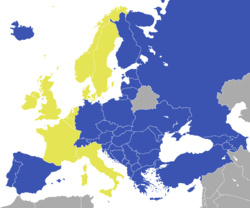Turkey
Coordinates: 39°N 35°E / 39°N 35°E
Turkey (![]() i/ˈtɜːrki/; Turkish: Türkiye [ˈtyɾcije]), officially the Republic of Turkey (Turkish:
i/ˈtɜːrki/; Turkish: Türkiye [ˈtyɾcije]), officially the Republic of Turkey (Turkish: ![]() Türkiye Cumhuriyeti ; pronounced [ˈtyɾcije d͡ʒumˈhuɾijeti]), is a transcontinental country in Eurasia, mainly on the Anatolian peninsula in Western Asia, with a smaller portion on the Balkan peninsula in Southeast Europe.[7] Turkey is a democratic, secular, unitary, parliamentary republic with a diverse cultural heritage.[8]
Türkiye Cumhuriyeti ; pronounced [ˈtyɾcije d͡ʒumˈhuɾijeti]), is a transcontinental country in Eurasia, mainly on the Anatolian peninsula in Western Asia, with a smaller portion on the Balkan peninsula in Southeast Europe.[7] Turkey is a democratic, secular, unitary, parliamentary republic with a diverse cultural heritage.[8]
Turkey is bordered by eight countries: Greece to the west; Bulgaria to the northwest; Georgia to the northeast; Armenia, the Azerbaijani exclave of Nakhchivan and Iran to the east; and Iraq and Syria to the south. The Aegean Sea is to the west, the Black Sea to the north, and the Mediterranean Sea to the south. The Bosphorus, the Sea of Marmara, and the Dardanelles, which together form the Turkish Straits, divide Thrace and Anatolia; they also separate Europe and Asia.[9] Turkey's location between Europe and Asia has retained its geopolitical and strategic importance throughout history.[10][11]
Turkey has been inhabited since the Paleolithic[12] by various ancient Anatolian civilizations, as well as Assyrians, Greeks, Thracians, Phrygians, Urartians and Armenians.[13][14][15] After Alexander the Great's conquest, the area was Hellenized, a process which continued under the Roman Empire and its transition into the Byzantine Empire.[14][16] The Seljuk Turks began migrating into the area in the 11th century, starting the process of Turkification, which was accelerated by the Seljuk victory over the Byzantines at the Battle of Manzikert in 1071.[17] The Seljuk Sultanate of Rûm ruled Anatolia until the Mongol invasion in 1243, when it disintegrated into small Turkish beyliks.[18]
In the mid-14th century the Ottomans started uniting Anatolia and created an empire encompassing much of Southeastern Europe, Western Asia and North Africa, becoming a major power in Eurasia and Africa during the early modern period. The empire reached the peak of its power in the 16th century, especially during the reign (1520–1566) of Suleiman the Magnificent. The empire remained powerful and influential for two more centuries, until important setbacks such as the Great Turkish War (1683–99) and the Russo-Turkish War (1768–74) forced it to cede strategic territories in Europe, signalling the loss of its former military strength and wealth. The Tanzimat reforms of the 19th century, which aimed to modernize the Ottoman state, proved to be inadequate in most fields, and failed to stop the dissolution of the empire.[19]
Suspended by Sultan Abdülhamid II in 1878, the Ottoman constitution and parliament were restored with the Young Turk Revolution on 24 July 1908. Taking advantage of the chaos, Bulgaria formally declared its independence on 5 October 1908, and Austria-Hungary formally annexed Bosnia-Herzegovina on 6 October 1908. The Italo-Turkish War (1911–1912) encouraged the Balkan League to declare the Balkan Wars (1912–1913), which caused the Ottoman Empire to lose the majority of its remaining territories in Europe and triggered the largest ethnic cleansing of Turks in the Balkan peninsula since the Russo-Turkish War (1877–78), resulting in the mass migrations of Turks to Anatolia. The disappointment in these losses led to the 1913 Ottoman coup d'état which effectively put the country under the control of the Three Pashas, who decided to join the Central Powers of World War I (1914–1918) which were ultimately defeated by the Allied Powers. During the war, the Ottoman government committed ethnic cleansing or genocide against its Armenian, Assyrian and Pontic Greek citizens.[20] Following the war, the conglomeration of territories and peoples that formerly comprised the Ottoman Empire was divided into several new states.[21]
The Turkish War of Independence (1919–1922), initiated by Mustafa Kemal Atatürk and his colleagues in Anatolia against the occupying Allies, resulted in the abolition of monarchy in 1922 and the establishment of the modern Republic of Turkey in 1923, with Atatürk as its first president.[22]
Turkey's official language is Turkish, a Turkic language spoken natively by 84.5% of the population.[23] According to polls, between 78.1% and 81.3% of the country's citizens identify themselves as ethnic Turks.[23] Other ethnic groups include legally recognized (Armenians, Greeks, Jews) and unrecognized (Kurds, Circassians, Arabs, Albanians, Bosniaks, Georgians, etc.) minorities.[23] Kurds are the largest ethnic minority group, making up approximately 13.4%[23] to 18%[8] or up to 25%[24] of the population, based on polls and estimates. The vast majority of the population is nominally Sunni Muslim, with Alevis making up the largest religious minority.[8]
Turkey is a charter member of the UN, an early member of NATO, and a founding member of the OECD, OSCE, OIC and G-20. After becoming one of the first members of the Council of Europe in 1949, Turkey became an associate member of the EEC in 1963, applied for full EEC membership in 1987, joined the EU Customs Union in 1995 and started accession negotiations with the European Union in 2005.[25] Turkey's growing economy and diplomatic initiatives have led to its recognition as a regional power.[26][27][28][29]
Etymology
The name of Turkey (Turkish: Türkiye) is based on the ethnonym Türk. The first recorded use of the term "Türk" or "Türük" as an autonym is contained in the Old Turkic inscriptions of the Göktürks (Celestial Turks) of Central Asia (c. 8th century).[30] The English name Turkey first appeared in the late 14th century and is derived from Medieval Latin Turchia.[31]
The Greek cognate of this name, Tourkia (Greek: Τουρκία) was used by the Byzantine emperor and scholar Constantine VII Porphyrogenitus in his book De Administrando Imperio,[32][33] though in his use, "Turks" always referred to Magyars.[34] Similarly, the medieval Khazar Empire, a Turkic state on the northern shores of the Black and Caspian seas, was referred to as Tourkia (Land of the Turks) in Byzantine sources.[35] The Ottoman Empire was sometimes referred to as Turkey or the Turkish Empire among its European contemporaries.[36]
History
Prehistory of Anatolia and Eastern Thrace
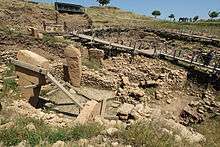

The Anatolian peninsula, comprising most of modern Turkey, is one of the oldest permanently settled regions in the world. Various ancient Anatolian populations have lived in Anatolia, from at least the Neolithic period until the Hellenistic period.[14] Many of these peoples spoke the Anatolian languages, a branch of the larger Indo-European language family.[39] In fact, given the antiquity of the Indo-European Hittite and Luwian languages, some scholars have proposed Anatolia as the hypothetical center from which the Indo-European languages radiated.[40] The European part of Turkey, called Eastern Thrace, has also been inhabited since at least forty thousand years ago, and is known to have been in the Neolithic era by about 6000 BC.[15]
Göbekli Tepe is the site of the oldest known man-made religious structure, a temple dating to 10,000 BC,[41] while Çatalhöyük is a very large Neolithic and Chalcolithic settlement in southern Anatolia, which existed from approximately 7500 BC to 5700 BC. It is the largest and best-preserved Neolithic site found to date and in July 2012 was inscribed as a UNESCO World Heritage Site.[42] The settlement of Troy started in the Neolithic Age and continued into the Iron Age.[43]
The earliest recorded inhabitants of Anatolia were the Hattians and Hurrians, non-Indo-European peoples who inhabited central and eastern Anatolia, respectively, as early as ca. 2300 BC. Indo-European Hittites came to Anatolia and gradually absorbed the Hattians and Hurrians ca. 2000–1700 BC. The first major empire in the area was founded by the Hittites, from the 18th through the 13th century BC. The Assyrians conquered and settled parts of southeastern Turkey as early as 1950 BC until the year 612 BC.[44][45] Urartu re-emerged in Assyrian inscriptions in the 9th century BC as a powerful northern rival of Assyria.[46]
Following the collapse of the Hittite empire c. 1180 BC, the Phrygians, an Indo-European people, achieved ascendancy in Anatolia until their kingdom was destroyed by the Cimmerians in the 7th century BC.[47] Starting from 714 BC, Urartu shared the same fate and dissolved in 590 BC,[48] when it was conquered by the Medes. The most powerful of Phrygia's successor states were Lydia, Caria and Lycia.
Antiquity and Byzantine period

.jpg)
Starting around 1200 BC, the coast of Anatolia was heavily settled by Aeolian and Ionian Greeks. Numerous important cities were founded by these colonists, such as Miletus, Ephesus, Smyrna (now İzmir) and Byzantium (now Istanbul), the latter founded by Greek colonists from Megara in 657 BC. The first state that was called Armenia by neighbouring peoples was the state of the Armenian Orontid dynasty, which included parts of eastern Turkey beginning in the 6th century BC. In Northwest Turkey, the most significant tribal group in Thrace was the Odyrisians, founded by Teres I.[49]
All of modern-day Turkey was conquered by the Persian Achaemenid Empire during the 6th century BC.[50] The Greco-Persian Wars started when the Greek city states on the coast of Anatolia rebelled against Persian rule in 499 BC. The territory of Turkey later fell to Alexander the Great in 334 BC,[51] which led to increasing cultural homogeneity and Hellenization in the area.[14]
Following Alexander's death in 323 BC, Anatolia was subsequently divided into a number of small Hellenistic kingdoms, all of which became part of the Roman Republic by the mid-1st century BC.[52] The process of Hellenization that began with Alexander's conquest accelerated under Roman rule, and by the early centuries AD the local Anatolian languages and cultures had become extinct, being largely replaced by ancient Greek language and culture.[16][53] From the 1st century BC up to the 3rd century AD, large parts of modern-day Turkey were contested between the Romans and neighboring Parthians through the frequent Roman-Parthian Wars.
In 324, Constantine I chose Byzantium to be the new capital of the Roman Empire, renaming it New Rome. Following the death of Theodosius I in 395 and the permanent division of the Roman Empire between his two sons, the city, which would popularly come to be known as Constantinople, became the capital of the Eastern Roman Empire. This, which would later be branded by historians as the Byzantine Empire, ruled most of the territory of present-day Turkey until the Late Middle Ages;[54] although the eastern regions remained in firm Sasanian hands up to the first half of the 7th century AD. The frequent Byzantine-Sassanid Wars, as part of the centuries long-lasting Roman-Persian Wars, fought between the neighboring rivaling Byzantines and Sasanians, took place in various parts of present-day Turkey and decided much of the latters history from the 4th century AD up to the first half of the 7th century AD.
Seljuks and the Ottoman Empire
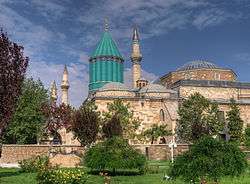
The House of Seljuk was a branch of the Kınık Oğuz Turks who resided on the periphery of the Muslim world, in the Yabgu Khaganate of the Oğuz confederacy, to the north of the Caspian and Aral Seas, in the 9th century.[56] In the 10th century, the Seljuks started migrating from their ancestral homeland into Persia, which became the administrative core of the Great Seljuk Empire.[57]
In the latter half of the 11th century, the Seljuk Turks began penetrating into medieval Armenia and the eastern regions of Anatolia. In 1071, the Seljuks defeated the Byzantines at the Battle of Manzikert, starting the Turkification process in the area; the Turkish language and Islam were introduced to Armenia and Anatolia, gradually spreading throughout the region. The slow transition from a predominantly Christian and Greek-speaking Anatolia to a predominantly Muslim and Turkish-speaking one was underway.[58] Alongside the Turkification of the territory, the culturally Persianized Seljuks set the basis for a Turko-Persian principal culture in Anatolia,[59] which their eventual successors, the Ottomans would take over.[60][61]
In 1243, the Seljuk armies were defeated by the Mongols, causing the Seljuk Empire's power to slowly disintegrate. In its wake, one of the Turkish principalities governed by Osman I would, over the next 200 years, evolve into the Ottoman Empire. In 1453, the Ottomans completed their conquest of the Byzantine Empire by capturing its capital, Constantinople.[62]
In 1514, Sultan Selim I (1512–1520) successfully expanded the empire's southern and eastern borders by defeating Shah Ismail I of the Safavid dynasty in the Battle of Chaldiran. In 1517, Selim I expanded Ottoman rule into Algeria and Egypt, and created a naval presence in the Red Sea. Subsequently, a competition started between the Ottoman and Portuguese empires to become the dominant sea power in the Indian Ocean, with a number of naval battles in the Red Sea, the Arabian Sea and the Persian Gulf. The Portuguese presence in the Indian Ocean was perceived as a threat for the Ottoman monopoly over the ancient trade routes between East Asia and Western Europe. Despite the increasingly prominent European presence, the Ottoman Empire's trade with the east continued to flourish until the second half of the 18th century.[65]
The Ottoman Empire's power and prestige peaked in the 16th and 17th centuries, particularly during the reign of Suleiman the Magnificent, who personally instituted major legislative changes relating to society, education, taxation and criminal law. The empire was often at odds with the Holy Roman Empire in its steady advance towards Central Europe through the Balkans and the southern part of the Polish-Lithuanian Commonwealth.[66] At sea, the Ottoman Navy contended with several Holy Leagues, such as those in 1538, 1571, 1684 and 1717 (composed primarily of Habsburg Spain, the Republic of Genoa, the Republic of Venice, the Knights of St. John, the Papal States, the Grand Duchy of Tuscany and the Duchy of Savoy), for the control of the Mediterranean Sea. In the east, the Ottomans were often at war with Safavid Persia over conflicts stemming from territorial disputes or religious differences between the 16th and 18th centuries.[67] The Ottoman wars with Persia continued as the Zand, Afsharid, and Qajar dynasties succeeded the Safavids in Iran, until the first half of the 19th century. From the 16th to the early 20th centuries, the Ottoman Empire also fought many wars with the Russian Tsardom and Empire. These were initially about the Ottoman territorial expansion and consolidation in southeastern and eastern Europe; but starting from the latter half of the 18th century, they became more about the survival of the Ottoman state, which began to lose its strategic territories on the northern Black Sea coast to the advancing Russians. Between the 18th and the early 20th centuries, the Ottoman, Persian and Russian empires were neighbouring rivals of each other.
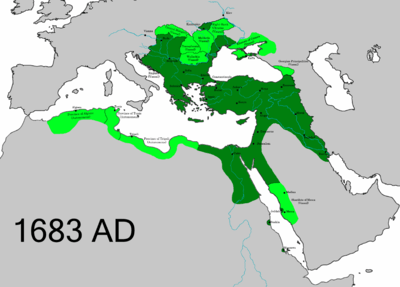
From the second half of the 18th century onwards, the Ottoman Empire began to decline. The Tanzimat reforms of the 19th century aimed to modernize the Ottoman state in line with the progress that was made in the West, but these efforts proved to be inadequate in most fields, and failed to stop the dissolution of the empire.[19] As it gradually shrank in size, military power and wealth, especially after the Ottoman economic crisis and default in 1875[68] which led to uprisings in the Balkan provinces that culminated into the Russo-Turkish War of 1877–78, many Balkan Muslims migrated to the Empire's heartland in Anatolia,[69][70] along with the Circassians fleeing the Russian conquest of the Caucasus. The decline of the Ottoman Empire led to a rise in nationalist sentiment among the various subject peoples, leading to increased ethnic tensions which occasionally burst into violence, such as the Hamidian massacres of Armenians.[71]
The Young Turk Revolution in 1908 restored the Ottoman constitution and parliament 30 years after their suspension by Sultan Abdülhamid II in 1878, but the 1913 Ottoman coup d'état effectively put the country under the control of the Three Pashas. This made sultans Mehmed V and Mehmed VI largely symbolic figureheads with no real political power.
The Ottoman Empire entered World War I on the side of the Central Powers and was ultimately defeated. During the war, the empire's Armenians were deported to Syria as part of the Armenian Genocide. As a result, an estimated 800,000 to 1,500,000 Armenians were killed.[72][73][74][75] The Turkish government has refused to acknowledge the events as genocide and claims that Armenians were only relocated from the eastern war zone.[76] Large-scale massacres were also committed against the empire's other minority groups such as the Assyrians and Greeks.[77][78][79] Following the Armistice of Mudros on 30 October 1918, the victorious Allied Powers sought to partition the Ottoman state through the 1920 Treaty of Sèvres.[62]
Republic of Turkey

The occupation of Istanbul and Izmir by the Allies in the aftermath of World War I prompted the establishment of the Turkish National Movement. Under the leadership of Mustafa Kemal Pasha, a military commander who had distinguished himself during the Battle of Gallipoli, the Turkish War of Independence was waged with the aim of revoking the terms of the Treaty of Sèvres.[80]
By 18 September 1922 the occupying armies were expelled,[81] and the Ankara-based Turkish regime, which had declared itself the legitimate government of the country on 23 April 1920, started to formalize the legal transition from the old Ottoman into the new Republican political system. On 1 November 1922, the Turkish Parliament in Ankara formally abolished the Sultanate, thus ending 623 years of monarchical Ottoman rule. The Treaty of Lausanne of 24 July 1923 led to the international recognition of the sovereignty of the newly formed "Republic of Turkey" as the successor state of the Ottoman Empire, and the republic was officially proclaimed on 29 October 1923 in Ankara, the country's new capital.[82] The Lausanne treaty stipulated a population exchange between Greece and Turkey, whereby 1.1 million Greeks left Turkey for Greece in exchange for 380,000 Muslims transferred from Greece to Turkey.[83]
Mustafa Kemal became the republic's first President and subsequently introduced many radical reforms with the aim of transforming the old religion-based and multi-communal Ottoman state system (constitutional monarchy) into an essentially Turkish nation state (parliamentary republic) with a secular constitution.[84] With the Surname Law of 1934, the Turkish Parliament bestowed upon Mustafa Kemal the honorific surname "Atatürk" (Father of the Turks).[80]

Turkey remained neutral during most of World War II, but entered the closing stages of the war on the side of the Allies on 23 February 1945. On 26 June 1945, Turkey became a charter member of the United Nations.[85] Difficulties faced by Greece after the war in quelling a communist rebellion, along with demands by the Soviet Union for military bases in the Turkish Straits, prompted the United States to declare the Truman Doctrine in 1947. The doctrine enunciated American intentions to guarantee the security of Turkey and Greece, and resulted in large-scale U.S. military and economic support. Both countries were included in the Marshall Plan and OEEC for rebuilding European economies in 1948,[86] and subsequently became founding members of the OECD in 1961.[87]
After participating with the United Nations forces in the Korean War, Turkey joined NATO in 1952, becoming a bulwark against Soviet expansion into the Mediterranean. Following a decade of Cypriot intercommunal violence and the coup in Cyprus on 15 July 1974 staged by the EOKA B paramilitary organization, which overthrew President Makarios and installed the pro-Enosis (union with Greece) Nikos Sampson as dictator, Turkey invaded Cyprus on 20 July 1974.[88] Nine years later the Turkish Republic of Northern Cyprus, which is recognized only by Turkey, was established.[89]
The single-party period ended in 1945. It was followed by a tumultuous transition to multiparty democracy over the next few decades, which was interrupted by military coups d'état in 1960, 1971, and 1980, as well as a military memorandum in 1997.[90][91] In 1984, the PKK, a Kurdish separatist group, began an insurgency campaign against the Turkish government. The Kurdish-Turkish conflict to date has claimed over 40,000 lives.[92] Over 3,000 Kurdish villages were burned by Turkish security forces and hundreds of thousands of Kurds displaced,[93] and Kurdish political parties were banned.[94] Peace talks were launched in 2012,[95][96] but hostilities restarted in 2015 following the Suruc bombing.[97] Since the liberalization of the Turkish economy during the 1980s, the country has enjoyed stronger economic growth and greater political stability.[98] In 2013, widespread protests erupted in many Turkish provinces, sparked by a plan to demolish Gezi Park but growing into general anti-government dissent.[99] On 15–16 July 2016, an unsuccessful coup attempt tried to oust the government.[100]
Administrative divisions
Turkey has a unitary structure in terms of administration and this aspect is one of the most important factors shaping the Turkish public administration. When three powers (executive, legislative and judiciary) are taken into account as the main functions of the state, local administrations have little power. Turkey is a unitary not a federal system, and the provinces are subordinated to the centre. Local administrations were established to provide services in place and the government is represented by the governors and city governors. Besides the governors and the city governors, other senior public officials are also appointed by the central government rather than appointed by mayors or elected by constituents.[101]
Turkey is subdivided into 81 provinces for administrative purposes. Each province is divided into districts, for a total of 923 districts.[102]
Turkey is also subdivided into 7 regions and 21 subregions for geographic, demographic and economic purposes; this does not refer to an administrative division.
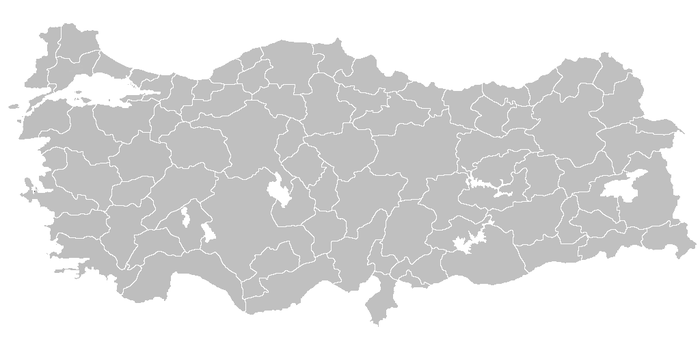
Politics
| |
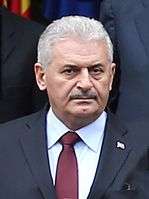 |
| Tayyip Erdoğan President |
Binali Yıldırım Prime Minister |
Turkey is a parliamentary representative democracy. Since its foundation as a republic in 1923, Turkey has developed a strong tradition of secularism.[103] Turkey's constitution governs the legal framework of the country. It sets out the main principles of government and establishes Turkey as a unitary centralized state. The President of the Republic is the head of state and has a largely ceremonial role. The president is elected for a five-year term by direct elections and Tayyip Erdoğan is the first president elected by direct voting.
Executive power is exercised by the Prime Minister and the Council of Ministers which make up the government, while the legislative power is vested in the unicameral parliament, the Grand National Assembly of Turkey. The judiciary is independent of the executive and the legislature, and the Constitutional Court is charged with ruling on the conformity of laws and decrees with the constitution. The Council of State is the tribunal of last resort for administrative cases, and the High Court of Appeals for all others.[104]
The prime minister is elected by the parliament through a vote of confidence in the government and is most often the head of the party having the most seats in parliament. The prime minister is Binali Yıldırım, who replaced Ahmet Davutoğlu on 24 May 2016.
Universal suffrage for both sexes has been applied throughout Turkey since 1933, and every Turkish citizen who has turned 18 years of age has the right to vote. There are 550 members of parliament who are elected for a four-year term by a party-list proportional representation system from 85 electoral districts. The Constitutional Court can strip the public financing of political parties that it deems anti-secular or separatist, or ban their existence altogether.[105][106] The electoral threshold is 10 percent of the votes.[107]
Supporters of Atatürk's reforms are called Kemalists, as distinguished from Islamists, representing two extremes on a continuum of beliefs about the proper role of religion in public life.[108] The Kemalist position generally combines a kind of democracy with a laicist constitution and westernised secular lifestyle, while supporting state intervention in the economy, education, and other public services.[108] Since the 1980s, a rise in income inequality and class distinction has given rise to Islamic populism, a movement that in theory supports obligation to authority, communal solidarity and social justice, though what that entails in practice is often contested.[108]
Human rights

Human rights in Turkey have been the subject of some controversy and international condemnation. Between 1998 and 2008 the European Court of Human Rights made more than 1,600 judgements against Turkey for human rights violations, particularly regarding the right to life, and freedom from torture. Other issues, such as Kurdish rights, women's rights, LGBT rights, and press freedom, have also attracted controversy. Turkey's human rights record continues to be a significant obstacle to future membership of the EU.[109] According to the Committee to Protect Journalists, the AKP government has waged one of the world's biggest crackdowns on press freedoms.[110] A large number of journalists have been arrested using charges of "terrorism" and "anti-state activities" such as the Ergenekon and Balyoz cases, while thousands have been investigated on charges such as "denigrating Turkishness" or "insulting Islam" in an effort to sow self-censorship.[110] In 2012, the CPJ identified 76 jailed journalists in Turkey, including 61 directly held for their published work, ranking 1st in the world, more than in Iran, Eritrea or China[110] while Freemuse identified 9 musicians imprisoned for their work, ranking 3rd after Russia and China.[111] A former U.S. State Department spokesman, Philip J. Crowley, said that the United States had "broad concerns about trends involving intimidation of journalists in Turkey."[112] Turkey's media is rated as not free by Freedom House.[113]
In its resolution "The functioning of democratic institutions in Turkey" on 22 June 2016, the Parliamentary Assembly of the Council of Europe warned that "recent developments in Turkey pertaining to freedom of the media and of expression, erosion of the rule of law and the human rights violations in relation to anti-terrorism security operations in south-east Turkey have (...) raised serious questions about the functioning of its democratic institutions."[114]
Law
Turkey has a legal system which has been wholly integrated with the system of continental Europe. For instance, the Turkish Civil Law has been modified by incorporating elements mainly of the Swiss Civil Code, the Code of Obligations and the German Commercial Code. The Administrative Law bears similarities with its French counterpart, and the Penal Code with its Italian counterpart.[115]
Turkey has adopted the principle of the separation of powers. In line with this principle, judicial power is exercised by independent courts on behalf of the Turkish nation. The independence and organization of the courts, the security of the tenure of judges and public prosecutors, the profession of judges and prosecutors, the supervision of judges and public prosecutors, the military courts and their organization, and the powers and duties of the high courts are regulated by the Turkish Constitution.[116]
According to Article 142 of the Turkish Constitution, the organization, duties and jurisdiction of the courts, their functions and the trial procedures are regulated by law. In line with the aforementioned article of the Turkish Constitution and related laws, the court system in Turkey can be classified under three main categories; which are the Judicial Courts, Administrative Courts and Military Courts. Each category includes first instance courts and high courts. In addition, the Court of Jurisdictional Disputes rules on cases that cannot be classified readily as falling within the purview of one court system.[116]
Law enforcement in Turkey is carried out by several departments (such as the General Directorate of Security and Gendarmerie General Command) and agencies, all acting under the command of the Prime Minister of Turkey or mostly the Minister of Internal Affairs. According to figures released by the Justice Ministry, there are 100,000 people in Turkish prisons as of November 2008, a doubling since 2000.[117]
In the years of government by the AKP and Tayyip Erdoğan, particularly since 2013, the independence and integrity of the Turkish judiciary has increasingly been considered in doubt by institutions, parliamentarians and journalists both within and outside of Turkey; due to political interference in the promotion of judges and prosecutors, and in their pursuit of public duty.[118][119][120][121] The Turkey 2015 report of the European Commission stated that "the independence of the judiciary and respect of the principle of separation of powers have been undermined and judges and prosecutors have been under strong political pressure."[118]
Foreign relations
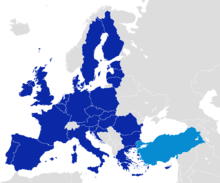
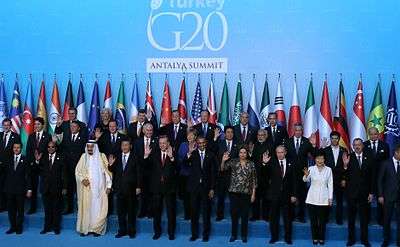
Turkey is a founding member of the United Nations (1945),[122] the OECD (1961),[123] the OIC (1969),[124] the OSCE (1973),[125] the ECO (1985),[126] the BSEC (1992),[127] the D-8 (1997)[128] and the G-20 (1999).[129] Turkey was a member of the United Nations Security Council in 1951–1952, 1954–1955, 1961 and 2009–2010.[130] In September 2013, Turkey became a member of the Asia Cooperation Dialogue (ACD).
In line with its traditional Western orientation, relations with Europe have always been a central part of Turkish foreign policy. Turkey became one of the first members of the Council of Europe in 1949, applied for associate membership of the EEC (predecessor of the European Union) in 1959 and became an associate member in 1963. After decades of political negotiations, Turkey applied for full membership of the EEC in 1987, became an associate member of the Western European Union in 1992, joined the EU Customs Union in 1995 and has been in formal accession negotiations with the EU since 2005.[25] Today, EU membership is considered as a state policy and a strategic target by Turkey. Turkey's support for Northern Cyprus in the Cyprus dispute complicates Turkey's relations with the EU and remains a major stumbling block to the country's EU accession bid.[131]
The other defining aspect of Turkey's foreign policy was the country's long-standing strategic alliance with the United States.[132][133] The common threat posed by the Soviet Union during the Cold War led to Turkey's membership of NATO in 1952, ensuring close bilateral relations with Washington. Subsequently Turkey benefited from the United States' political, economic and diplomatic support, including in key issues such as the country's bid to join the European Union.[134] In the post–Cold War environment, Turkey's geostrategic importance shifted towards its proximity to the Middle East, the Caucasus and the Balkans.[135]
The independence of the Turkic states of the Soviet Union in 1991, with which Turkey shares a common cultural and linguistic heritage, allowed Turkey to extend its economic and political relations deep into Central Asia,[136] thus enabling the completion of a multi-billion-dollar oil and natural gas pipeline from Baku in Azerbaijan to the port of Ceyhan in Turkey. The Baku–Tbilisi–Ceyhan pipeline forms part of Turkey's foreign policy strategy to become an energy conduit to the West. However Turkey's border with Armenia, a state in the Caucasus, was closed by Turkey in support of Azerbaijan during the Nagorno-Karabakh War and remains closed.[137]
Under the AKP government, Turkey's influence has grown in the formerly Ottoman territories of the Middle East and the Balkans, based on the "strategic depth" doctrine (a terminology that was coined by Ahmet Davutoğlu for defining Turkey's increased engagement in regional foreign policy issues), also called Neo-Ottomanism.[138][139] Following the Arab Spring in December 2010, the choices made by the AKP government for supporting certain political opposition groups in the affected countries have led to tensions with some Arab states, such as Turkey's neighbour Syria since the start of the Syrian civil war, and Egypt after the ousting of President Mohamed Morsi.[140][141] As of 2016, Turkey doesn't have an ambassador in Syria and Egypt.[142] Diplomatic relations with Israel were also severed after the Gaza flotilla raid in 2010, but were normalized following a deal in June 2016.[143] These political rifts have left Turkey with few allies in the East Mediterranean, where rich natural gas fields have recently been discovered;[144][145] in sharp contrast with the original goals that were set by the former Foreign Minister (later Prime Minister) Ahmet Davutoğlu in his "zero problems with neighbours"[146][147] foreign policy doctrine.[148] In 2015, Turkey, Saudi Arabia and Qatar formed a "strategic alliance" against Syrian President Bashar al-Assad.[149][150]
Turkey has maintained forces in international missions under the United Nations and NATO since 1950, including peacekeeping missions in Somalia and former Yugoslavia, and support to coalition forces in the First Gulf War. Turkey maintains 36,000 troops in Northern Cyprus, though their presence is controversial,[151] and assists Iraqi Kurdistan with security. Turkey has had troops deployed in Afghanistan as part of the United States stabilization force and the UN-authorized, NATO-commanded International Security Assistance Force (ISAF) since 2001.[152] Since 2003, Turkey contributes military personnel to Eurocorps and takes part in the EU Battlegroups.[153]
Military
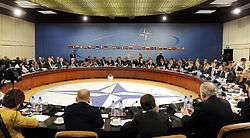
The Turkish Armed Forces consists of the Land Forces, the Naval Forces and the Air Force. The Gendarmerie and the Coast Guard operate as parts of the Ministry of Internal Affairs in peacetime, although they are subordinated to the Army and Navy Commands respectively in wartime, during which they have both internal law enforcement and military functions.[155]
The Chief of the General Staff is appointed by the President and is responsible to the Prime Minister. The Council of Ministers is responsible to the Parliament for matters of national security and the adequate preparation of the armed forces to defend the country. However, the authority to declare war and to deploy the Turkish Armed Forces to foreign countries or to allow foreign armed forces to be stationed in Turkey rests solely with the Parliament.[155]
Turkey has the second largest standing military force in NATO, after the U.S. Armed Forces, with an estimated strength of 495,000 deployable forces, according to a 2011 NATO estimate.[156] Turkey is one of five NATO member states which are part of the nuclear sharing policy of the alliance, together with Belgium, Germany, Italy, and the Netherlands.[157] A total of 90 B61 nuclear bombs are hosted at the Incirlik Air Base, 40 of which are allocated for use by the Turkish Air Force in case of a nuclear conflict, but their use requires the approval of NATO.[158]
Every fit male Turkish citizen otherwise not barred is required to serve in the military for a period ranging from three weeks to a year, dependent on education and job location.[159] Turkey does not recognise conscientious objection and does not offer a civilian alternative to military service.[160]
Geography
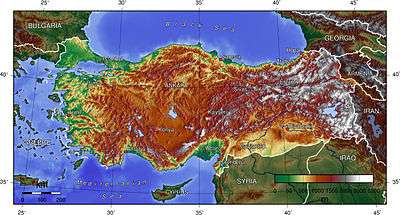
Turkey is a transcontinental[161] Eurasian country. Asian Turkey, which includes 97 percent of the country, is separated from European Turkey by the Bosphorus, the Sea of Marmara, and the Dardanelles. European Turkey comprises 3 percent of the country.[162] The territory of Turkey is more than 1,600 kilometres (990 miles) long and 800 kilometres (500 miles) wide, with a roughly rectangular shape.[163] It lies between latitudes 35° and 43° N, and longitudes 25° and 45° E. Turkey's land area, including lakes, occupies 783,562 square kilometres (302,535 square miles),[164] of which 755,688 square kilometres (291,773 square miles) are in Southwest Asia and 23,764 square kilometres (9,175 square miles) in Europe.[163] Turkey is the world's 37th-largest country in terms of area. The country is encircled by seas on three sides: the Aegean Sea to the west, the Black Sea to the north and the Mediterranean to the south. Turkey also contains the Sea of Marmara in the northwest.[165]
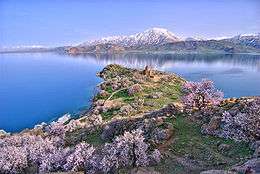
The European section of Turkey, East Thrace (the easternmost region of the Balkan peninsula), forms the borders of Turkey with Greece and Bulgaria. The Asian part of the country is comprised mostly by the peninsula of Anatolia, which consists of a high central plateau with narrow coastal plains, between the Köroğlu and Pontic mountain ranges to the north and the Taurus Mountains to the south. Eastern Turkey, located within the western plateau of the Armenian Highlands, has a more mountainous landscape and is home to the sources of rivers such as the Euphrates, Tigris and Aras, and contains Mount Ararat, Turkey's highest point at 5,137 metres (16,854 feet),[167] and Lake Van, the largest lake in the country.[166] Southeastern Turkey is located within the northern plains of Upper Mesopotamia.
Turkey is divided into seven geographical regions: Marmara, Aegean, Black Sea, Central Anatolia, Eastern Anatolia, Southeastern Anatolia and the Mediterranean. The uneven north Anatolian terrain running along the Black Sea resembles a long, narrow belt. This region comprises approximately one-sixth of Turkey's total land area. As a general trend, the inland Anatolian plateau becomes increasingly rugged as it progresses eastward.[165]
Turkey's varied landscapes are the product of complex earth movements that have shaped the region over thousands of years and still manifest themselves in fairly frequent earthquakes and occasional volcanic eruptions. The Bosphorus and the Dardanelles owe their existence to the fault lines running through Turkey that led to the creation of the Black Sea. The North Anatolian Fault Line runs across the north of the country from west to east, along which major earthquakes took place in history. The latest of those big earthquakes was the 1999 İzmit earthquake.
Biodiversity
Turkey's extraordinary ecosystem and habitat diversity has produced considerable species diversity.[168] Anatolia is the homeland of many plants that have been cultivated for food since the advent of agriculture, and the wild ancestors of many plants that now provide staples for humankind still grow in Turkey. The diversity of Turkey's fauna is even greater than that of its flora. The number of animal species in the whole of Europe is around 60,000, while in Turkey there are over 80,000 (over 100,000 counting the subspecies).[169]
The Northern Anatolian conifer and deciduous forests is an ecoregion which covers most of the Pontic Mountains in northern Turkey, while the Caucasus mixed forests extend across the eastern end of the range. The region is home to Eurasian wildlife such as the Eurasian sparrowhawk, golden eagle, eastern imperial eagle, lesser spotted eagle, Caucasian black grouse, red-fronted serin, and wallcreeper.[170] The narrow coastal strip between the Pontic Mountains and the Black Sea is home to the Euxine-Colchic deciduous forests, which contain some of the world's few temperate rainforests.[171] The Turkish pine is mostly found in Turkey and other east Mediterranean countries. Several wild species of tulip are native to Anatolia, and the flower was first introduced to Western Europe with species taken from the Ottoman Empire in the 16th century.[172][173]
There are 40 national parks, 189 nature parks, 31 nature preserve areas, 80 wildlife protection areas and 109 nature monuments in Turkey such as Gallipoli Peninsula Historical National Park, Mount Nemrut National Park, Ancient Troya National Park, Ölüdeniz Nature Park and Polonezköy Nature Park.[174]
Ankara, the capital of Turkey, is renowned for the Angora cat, Angora rabbit and Angora goat. Another national cat breed of Turkey is the Van cat. The national dog breeds are the Anatolian Shepherd, Kangal, Malaklı and Akbaş.[175]
The last confirmed death of an Anatolian leopard, closely related to the Persian (Caucasian) leopard and native to the western regions of Anatolia, took place in the Bağözü village of the Beypazarı district in Ankara Province on 17 January 1974.[176][177] The Persian (Caucasian) leopard is still found in very small numbers in the northeastern and southeastern regions of Turkey.[178][179] The Caspian tiger is an extinct tiger subspecies (closely related to the Siberian tiger) which lived in the easternmost regions of Turkey until the latter half of the 20th century, with the last confirmed death in Uludere, February 1970.[178][180] The Eurasian lynx and the European wildcat are other felid species which are currently found in the forests of Turkey.
Climate

The coastal areas of Turkey bordering the Aegean and Mediterranean Seas have a temperate Mediterranean climate, with hot, dry summers and mild to cool, wet winters.[181] The coastal areas bordering the Black Sea have a temperate oceanic climate with warm, wet summers and cool to cold, wet winters.[181] The Turkish Black Sea coast receives the greatest amount of precipitation and is the only region of Turkey that receives high precipitation throughout the year.[181] The eastern part of that coast averages 2,200 millimetres (87 in) annually which is the highest precipitation in the country.[181]
The coastal areas bordering the Sea of Marmara, which connects the Aegean Sea and the Black Sea, have a transitional climate between a temperate Mediterranean climate and a temperate oceanic climate with warm to hot, moderately dry summers and cool to cold, wet winters.[181] Snow falls on the coastal areas of the Sea of Marmara and the Black Sea almost every winter, but usually melts in no more than a few days.[181] However snow is rare in the coastal areas of the Aegean Sea and very rare in the coastal areas of the Mediterranean Sea.[181]
.png)
Mountains close to the coast prevent Mediterranean influences from extending inland, giving the central Anatolian plateau of the interior of Turkey a continental climate with sharply contrasting seasons.[181]
Winters on the eastern part of the plateau are especially severe.[181] Temperatures of −30 to −40 °C (−22 to −40 °F) can occur in eastern Anatolia.[181] Snow may remain at least 120 days of the year.[181] In the west, winter temperatures average below 1 °C (34 °F).[181] Summers are hot and dry, with temperatures often above 30 °C (86 °F) in the day.[181] Annual precipitation averages about 400 millimetres (15 in), with actual amounts determined by elevation. The driest regions are the Konya plain and the Malatya plain, where annual rainfall is often less than 300 millimetres (12 in). May is generally the wettest month, whereas July and August are the driest.[181]
Economy
Turkey has the world's 17th largest GDP by PPP[183] and 18th largest nominal GDP.[184] The country is among the founding members of the OECD and the G-20.[123][129]
The EU – Turkey Customs Union in 1995 led to an extensive liberalization of tariff rates, and forms one of the most important pillars of Turkey's foreign trade policy.[185] Turkey's exports were $143.5 billion in 2011 and reached $163 billion in 2012 (main export partners in 2012: Germany 8.6%, Iraq 7.1%, Iran 6.5%, UK 5.7%, UAE 5.4%). However, larger imports which amounted to $229 billion in 2012 threatened the balance of trade (main import partners in 2012: Russia 11.3%, Germany 9%, China 9%, US 6%, Italy 5.6%).[8]
Turkey has a sizeable automotive industry, which produced over 1.3 million motor vehicles in 2015, ranking as the 14th largest producer in the world.[186] Turkish shipbuilding exports were worth US$1.2 billion in 2011.[187] The major export markets are Malta, Marshall Islands, Panama and the United Kingdom. Turkish shipyards have 15 floating docks of different sizes and one dry dock.[187] Tuzla, Yalova, and İzmit have developed into dynamic shipbuilding centres.[188] In 2011, there were 70 active shipyards in Turkey, with another 56 being built.[188] Turkish shipyards are highly regarded both for the production of chemical and oil tankers up to 10,000 dwt and also for their mega yachts.[188]


Turkish brands like Beko and Vestel are among the largest producers of consumer electronics and home appliances in Europe, and invest a substantial amount of funds for research and development in new technologies related to these fields.[189][190][191]
Other key sectors of the Turkish economy are banking, construction, home appliances, electronics, textiles, oil refining, petrochemical products, food, mining, iron and steel, and machine industry. In 2010, the agricultural sector accounted for 9 percent of GDP, while the industrial sector accounted for 26 percent and the services sector for 65 percent.[8] However, agriculture still accounted for a quarter of employment.[192] In 2004, it was estimated that 46 percent of total disposable income was received by the top 20 percent of income earners, while the lowest 20 percent received only 6 percent.[193] The rate of female employment in Turkey was 30 percent in 2012,[194] the lowest among all OECD countries.[195]
Foreign direct investment (FDI) was $8.3 billion in 2012, a figure expected to rise to $15 billion in 2013.[196] In 2012, Fitch Group upgraded Turkey's credit rating to investment grade after an 18-year gap;[197] this was followed by a ratings upgrade by Moody's in May 2013, as the service lifted Turkey's government bond ratings to the lowest investment grade Baa3.[198][199]
History
In the early decades of the Turkish Republic, the government (or banks established and owned by the government, such as Türkiye İş Bankası (1924), Sanayi ve Maadin Bankası (1925), Emlak ve Eytam Bankası (1926), Central Bank of Turkey (1930), Sümerbank (1933), İller Bankası (1933), Etibank (1935), Denizbank (1937), Halk Bankası (1938), etc.) had to subsidize most of the industrial projects, due to the lack of a strong private sector. However, in the period between the 1920s and 1950s, a new generation of Turkish entrepreneurs such as Nuri Demirağ, Vehbi Koç, Hacı Ömer Sabancı and Nejat Eczacıbaşı began to establish privately owned factories, some of which evolved into the largest industrial conglomerates that dominate the Turkish economy today, such as Koç Holding, Sabancı Holding and Eczacıbaşı Holding.
During the first six decades of the republic, between 1923 and 1983, Turkey generally adhered to a quasi-statist approach with strict government planning of the budget and government-imposed limitations over foreign trade, flow of foreign currency, foreign direct investment and private sector participation in certain fields (such as broadcasting, telecommunications, energy, mining, etc.). However, in 1983, Prime Minister Turgut Özal initiated a series of reforms designed to shift the economy from a statist, insulated system to a more private-sector, market-based model.[98]
The reforms, combined with unprecedented amounts of funding from foreign loans, spurred rapid economic growth; but this growth was punctuated by sharp recessions and financial crises in 1994, 1999 (following the earthquake of that year),[200] and 2001;[201] resulting in an average of 4 percent GDP growth per annum between 1981 and 2003.[202] Lack of additional fiscal reforms, combined with large and growing public sector deficits and widespread corruption, resulted in high inflation, a weak banking sector and increased macroeconomic volatility.[203] Since the economic crisis of 2001 and the reforms initiated by the finance minister of the time, Kemal Derviş, inflation has dropped to single-digit figures for the first time in decades (8% in 2005), investor confidence and foreign investment have soared, and unemployment has fallen (10% in 2005).[204]
Turkey has gradually opened up its markets through economic reforms by reducing government controls on foreign trade and investment and the privatization of publicly owned industries, and the liberalization of many sectors to private and foreign participation has continued amid political debate.[205] The public debt-to-GDP ratio peaked at 75.9 percent during the recession of 2001, falling to an estimated 26.9 percent by 2013.[206]
The real GDP growth rate from 2002 to 2007 averaged 6.8 percent annually,[207] which made Turkey one of the fastest growing economies in the world during that period. However, growth slowed to 1 percent in 2008, and in 2009 the Turkish economy was affected by the global financial crisis, with a recession of 5 percent. The economy was estimated to have returned to 8 percent growth in 2010.[8] According to Eurostat data, Turkish GDP per capita adjusted by purchasing power standard stood at 52 percent of the EU average in 2011.[208]
In the early years of the 21st century, the chronically high inflation was brought under control; this led to the launch of a new currency, the Turkish new lira (Yeni Türk Lirası) in 2005, to cement the acquisition of the economic reforms and erase the vestiges of an unstable economy.[209] In 2009, after only four years in circulation, the Turkish new lira was renamed back to the Turkish lira with the introduction of new banknotes and coins (and the withdrawal of the Turkish new lira banknotes and coins that were introduced in 2005), but the ISO 4217 code of the Turkish new lira (TRY) remains in use for the current Turkish lira in the foreign exchange market.
Tourism
Tourism in Turkey has experienced rapid growth in the last twenty years, and constitutes an important part of the economy. The Turkish Ministry of Culture and Tourism currently promotes Turkish tourism under the Turkey Home name. In 2013, 37.8 million foreign visitors arrived in Turkey, which ranked as the 6th most popular tourism destination in the world; they contributed $27.9 billion to Turkey's revenues.[210] In 2012, 15 percent of the tourists were from Germany, 11 percent from Russia, 8 percent from the United Kingdom, 5 percent from Bulgaria, 4 percent each from Georgia, the Netherlands and Iran, 3 percent from France, 2 percent each from the United States and Syria, and 40 percent from other countries.[211]
Turkey has 13 UNESCO World Heritage Sites, such as the "Historic Areas of Istanbul", the "Rock Sites of Cappadocia", the "Neolithic Site of Çatalhöyük", "Hattusa: the Hittite Capital", the "Archaeological Site of Troy", "Pergamon and its Multi-Layered Cultural Landscape", "Hierapolis – Pamukkale", and "Mount Nemrut";[212] and 51 World Heritage Sites in tentative list, such as the archaeological sites or historic urban centers of Göbekli Tepe, Gordion, Ephesus, Aphrodisias, Perga, Lycia, Sagalassos, Aizanoi, Zeugma, Ani, Harran, Mardin, Konya and Alanya.[213]
Turkey hosts two of the Seven Wonders of the Ancient World: the Mausoleum in Halicarnassus and the Temple of Artemis in Ephesus.[214]

Infrastructure

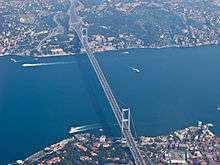
In 2013 there were 98 airports in Turkey,[221] including 22 international airports.[222] As of 2015, Istanbul Atatürk Airport is the 11th busiest airport in the world, serving 31,833,324 passengers between January and July 2014, according to Airports Council International.[223] The new (third) international airport of Istanbul is planned to be the largest airport in the world, with a capacity to serve 150 million passengers per annum.[224][225][226] Turkish Airlines, flag carrier of Turkey since 1933, was selected by Skytrax as Europe's best airline for five consecutive years in 2011, 2012, 2013, 2014 and 2015.[216][217][227] With 435 destinations (51 domestic and 384 international) in 126 countries worldwide, Turkish Airlines is the largest carrier in the world by number of countries served as of 2016.[218]
As of 2014, the country has a roadway network of 65,623 kilometres (40,776 miles).[228] The total length of the rail network was 10,991 km in 2008, including 2,133 kilometres (1,325 miles) of electrified and 457 kilometres (284 miles) of high-speed track.[229][230] The Turkish State Railways started building high-speed rail lines in 2003. The Ankara-Konya line became operational in 2011, while the Ankara-Istanbul line entered service in 2014.[230] Opened in 2013, the Marmaray tunnel under the Bosphorus connects the railway and metro lines of Istanbul's European and Asian sides; while the nearby Eurasia Tunnel will provide an undersea road connection for motor vehicles. The Bosphorus Bridge (1973), Fatih Sultan Mehmet Bridge (1988) and Yavuz Sultan Selim Bridge (2016) are the three suspension bridges connecting the European and Asian shores of the Bosphorus strait. The Osman Gazi Bridge (2016) connects the northern and southern shores of the Gulf of İzmit. The planned Çanakkale Bridge will connect the European and Asian shores of the Dardanelles strait.
In 2008, 7,555 kilometres (4,694 mi) of natural gas pipelines and 3,636 kilometres (2,259 mi) of petroleum pipelines spanned the country's territory.[229] The Baku-Tbilisi-Ceyhan pipeline, the second longest oil pipeline in the world, was inaugurated on 10 May 2005.[231] The Blue Stream, a major trans-Black Sea gas pipeline, delivers natural gas from Russia to Turkey. New undersea pipeline, with an annual capacity around 63 billion cubic metres (bcm), will allow Turkey to resell Russian gas to Europe.[232]
In 2013, the energy consumption was 240 billion kilowatt hours.[233] As Turkey imported 72 percent of its energy in 2013, the government decided to invest in nuclear power to reduce imports.[233] Three nuclear power stations are to be built by 2023.[233] Turkey has the fifth highest direct utilization and capacity of geothermal power in the world.[234] Turkey is a partner country of the EU INOGATE energy programme.[235]
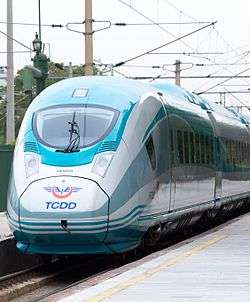
Turkey's first nuclear power plants are planned to be built in Mersin's Akkuyu district on the Mediterranean coast; in Sinop's İnceburun district on the Black Sea coast; and in Kırklareli's İğneada district on the Black Sea coast.[236] Turkey has the fifth highest direct utilization and capacity of geothermal power in the world.[234] Turkey is a partner country of the EU INOGATE energy programme, which has four key topics: enhancing energy security, convergence of member state energy markets on the basis of EU internal energy market principles, supporting sustainable energy development, and attracting investment for energy projects of common and regional interest.[235]
Turkey's internet, which has 35 million[237] active users, holds a 'Partly Free' ranking in Freedom House's index.[113]
Water supply and sanitation in Turkey is characterized by achievements and challenges. Over the past decades access to drinking water has become almost universal and access to adequate sanitation has also increased substantially. Autonomous utilities have been created in the 16 metropolitan cities of Turkey and cost recovery has been increased, thus providing the basis for the sustainability of service provision. Intermittent supply, which was common in many cities, has become less frequent. In 2004, 61% of the wastewater collected through sewers was being treated.
Remaining challenges include the need to further increase wastewater treatment, to reduce the high level of non-revenue water hovering around 50% and to expand access to adequate sanitation in rural areas. The investment required to comply with EU standards in the sector, especially in wastewater treatment, is estimated to be in the order of Euro 2 billion per year, more than double the current level of investment.[238]
Science and technology
TÜBİTAK is the leading agency for developing science, technology and innovation policies in Turkey.[240] TÜBA is an autonomous scholarly society acting to promote scientific activities in Turkey.[241] TAEK is the official nuclear energy institution of Turkey. Its objectives include academic research in nuclear energy, and the development and implementation of peaceful nuclear tools.[242]
Turkish government companies for research and development in military technologies include Turkish Aerospace Industries, Aselsan, Havelsan, Roketsan, MKE, among others. Turkish Satellite Assembly, Integration and Test Center (UMET) is a spacecraft production and testing facility owned by the Ministry of National Defence and operated by the Turkish Aerospace Industries (TAI). The Turkish Space Launch System (UFS) is a project to develop the satellite launch capability of Turkey. It consists of the construction of a spaceport, the development of satellite launch vehicles as well as the establishment of remote earth stations.[243][244][245]
In 2015, Aziz Sancar, a Turkish professor at the University of North Carolina, won the Nobel Chemistry Prize along with Tomas Lindahl and Paul Modrich, for their work on how cells repair damaged DNA.[246] Other notable Turkish scientists include physician Hulusi Behçet who discovered Behçet's disease, and mathematician Cahit Arf who defined the Arf invariant.
Demographics
| Historical populations | ||
|---|---|---|
| Year | Pop. | ±% p.a. |
| 1927 | 13,554,000 | — |
| 1930 | 14,440,000 | +2.13% |
| 1940 | 17,728,000 | +2.07% |
| 1950 | 20,807,000 | +1.61% |
| 1960 | 27,506,000 | +2.83% |
| 1970 | 35,321,000 | +2.53% |
| 1980 | 44,439,000 | +2.32% |
| 1990 | 55,120,000 | +2.18% |
| 2000 | 64,252,000 | +1.54% |
| 2010 | 73,003,000 | +1.29% |
| 2012 | 75,627,000 | +1.78% |
| Source: Turkstat[247] | ||
.png)
According to the Address-Based Population Recording System of Turkey, the country's population was 74.7 million people in 2011,[249] nearly three-quarters of whom lived in towns and cities. According to the 2011 estimate, the population is increasing by 1.35 percent each year. Turkey has an average population density of 97 people per km². People within the 15–64 age group constitute 67.4 percent of the total population; the 0–14 age group corresponds to 25.3 percent; while senior citizens aged 65 years or older make up 7.3 percent.[250] In 1927, when the first official census was recorded in the Republic of Turkey, the population was 13.6 million.[251] The largest city in Turkey, Istanbul, is also the largest city in Europe in population, and the third-largest city in Europe in terms of size.[252][253]
Article 66 of the Turkish Constitution defines a "Turk" as "anyone who is bound to the Turkish state through the bond of citizenship"; therefore, the legal use of the term "Turkish" as a citizen of Turkey is different from the ethnic definition.[254] However, the majority of the Turkish population are of Turkish ethnicity. They are estimated at 70–75 percent.[8] Reliable data on the ethnic mix of the population is not available, because Turkish census figures do not include statistics on ethnicity.[255] The three "Non-Muslim" minority groups claimed to be officially recognized in the Treaty of Lausanne are Armenians, Greeks and Jews. Officially unrecognized (mostly Muslim) ethnic groups include Albanians, Arabs, Assyrians, Azeris, Bosniaks, Circassians, Georgians, Lazs, Persians, Pomaks (Bulgarians), Yazidis and Roma.[256][257] The Kurds, a distinct ethnic group, are the largest non-Turkic ethnicity, around 18–25 percent of the population.[8][258] Kurds are concentrated in the east and southeast of the country, in what is also known as Turkish Kurdistan. Kurds make up a majority in the provinces of Tunceli, Bingöl, Muş, Ağrı, Iğdır, Elâzığ, Diyarbakır, Batman, Şırnak, Bitlis, Van, Mardin, Siirt and Hakkari, a near majority in Şanlıurfa province (47%), and a large minority in Kars province (20%).[259] In addition, due to internal migration, Kurdish communities exist in all major cities in central and western Turkey, particularly in Istanbul, where there are an estimated 3 million Kurds, making Istanbul the city with the largest Kurdish population in the world.[260] Minorities besides the Kurds are thought to make up an estimated 7–12 percent of the population.[8] Minorities other than the three officially recognized ones do not have any minority rights. The term "minority" itself remains a sensitive issue in Turkey, while the Turkish government is frequently criticized for its treatment of minorities.[261] Although minorities are not recognised, state-run Turkish Radio and Television Corporation (TRT) broadcasts television and radio programs in minority languages.[262][263] Also, some minority language classes can be chosen in elementary schools.[264]
An estimated 2.5 percent of the population are international migrants.[265] Turkey hosts the largest number of refugees in the world, including 2.2 million Syrian refugees, as of September 2015.[266][267][268]
Languages
The country's official language is Turkish, which is spoken by 85.54 percent of the population as mother tongue.[269] 11.97 percent of the population speaks the Kurmanji dialect of Kurdish as mother tongue.[269] Arabic and Zaza are the mother tongues of 2.39 percent of the population, and several other languages are the mother tongues of smaller parts of the population.[269] Endangered languages in Turkey include Abaza, Abkhaz, Adyge, Cappadocian Greek, Gagauz, Hértevin, Homshetsma, Kabard-Cherkes, Ladino (Judesmo), Laz, Mlahso, Pontic Greek, Romani, Suret, Turoyo, Ubykh, and Western Armenian.[270]
| | |||||||||
|---|---|---|---|---|---|---|---|---|---|
| Rank | Name | Province | Pop. | Rank | Name | Province | Pop. | ||
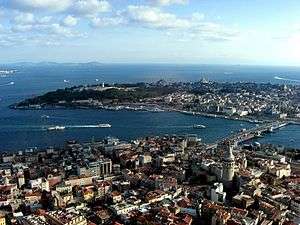 Istanbul  Ankara |
1 | Istanbul | Istanbul | 13,820,334 | 11 | Kayseri | Kayseri | 880,255 |  İzmir  Bursa |
| 2 | Ankara | Ankara | 4,474,305 | 12 | Eskişehir | Eskişehir | 670,544 | ||
| 3 | İzmir | İzmir | 2,828,927 | 13 | Gebze | Kocaeli | 582,352 | ||
| 4 | Bursa | Bursa | 1,769,752 | 14 | Şanlıurfa | Şanlıurfa | 551,511 | ||
| 5 | Adana | Adana | 1,645,965 | 15 | Denizli | Denizli | 540,000 | ||
| 6 | Gaziantep | Gaziantep | 1,465,019 | 16 | Samsun | Samsun | 523,192 | ||
| 7 | Konya | Konya | 1,138,609 | 17 | Kahramanmaraş | Kahramanmaraş | 458,628 | ||
| 8 | Antalya | Antalya | 1,027,551 | 18 | Adapazarı | Sakarya | 449,290 | ||
| 9 | Diyarbakır | Diyarbakır | 906,013 | 19 | Malatya | Malatya | 425,000 | ||
| 10 | Mersin | Mersin | 898,813 | 20 | Erzurum | Erzurum | 381,104 | ||
Religion
Turkey is a secular state with no official state religion; the Turkish Constitution provides for freedom of religion and conscience.[273][274] The role of religion has been a controversial debate over the years since the formation of Islamist parties.[275] For many decades, the wearing of the hijab was banned in schools and government buildings because it was viewed as a symbol of political Islam. However, the ban was lifted from universities in 2011, from government buildings in 2013,[276] and from schools in 2014.[277]
Islam
Islam is the dominant religion of Turkey with 99.8 percent of the population being registered as Muslim[8][278] (although some sources give a slightly lower estimate of 96.4 percent)[257] with the most popular sect being the Hanafite school of Sunni Islam. The highest Islamic religious authority is the Presidency of Religious Affairs (Turkish: Diyanet İşleri Başkanlığı); it interprets the Hanafi school of law, and is responsible for regulating the operation of the country's 80,000 registered mosques and employing local and provincial imams.[279] Academics suggest the Alevi population may be from 15 to 20 million while the Alevi-Bektaşi Federation claims that there are around 25 million[280][281] and according to Aksiyon magazine, the number of Shiite Twelvers (excluding Alevis) is 3 million (4.2 percent).[282] There are also some Sufi Muslims.[283] Roughly 2 percent are non-denominational Muslims.[284]
According to WIN-Gallup International's Global Index of Religiousity and Atheism project,[285] Turkey is the country with most irreligious Muslims in the Islamic world with 73% of its Muslim population. In light of an extensive PEW Global research, only 15% of Muslims in Turkey say prayers for at least one of the five prayers either at home or in a mosque.[286] Another PEW Report suggests that, only 7% to 13% of all Turks think that religion should have an effect on laws directly or indirectly.[287]
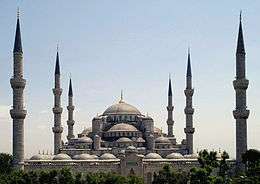
The percentage of non-Muslims in Turkey fell from 19 percent in 1914 to 2.5 percent in 1927,[289] due to events which had a significant impact on the country's demographic structure, such as the Armenian Genocide, the population exchange between Greece and Turkey,[290] and the emigration of non-Muslims (such as Levantines, Greeks, Armenians, Jews, etc.) to foreign countries (mostly in Europe and the Americas) that actually began in the late 19th century and gained pace in the first quarter of the 20th century, especially during World War I and after the Turkish War of Independence.[291] The Wealth Tax on non-Muslims in 1942, the emigration of a portion of Turkish Jews to Israel after 1948, and the ongoing Cyprus dispute which damaged the relations between Turks and Greeks (culminating in the Istanbul pogrom of 6–7 September 1955) were other important events that contributed to the decline of Turkey's non-Muslim population.
Christianity
Today there are more than 120,000 people of different Christian denominations, representing less than 0.2 percent of Turkey's population,[292] including an estimated 80,000 Oriental Orthodox, 35,000 Roman Catholics,[293] 18,000 Antiochian Greeks,[294] 5,000 Greek Orthodox, and smaller numbers of Protestants.[295] Currently there are 236 churches open for worship in Turkey.[296] The Eastern Orthodox Church has been headquartered in Istanbul since the 4th century.[297][298]
Judaism
There are about 26,000 people who are Jewish, the vast majority of whom are Sephardi.[299] There have been Jewish communities in Asia Minor since at least the 5th century BC and many Spanish and Portuguese Jews expelled from Spain were welcomed into the Ottoman Empire in the late 15th century. Despite emigration during the 20th century, modern-day Turkey continues to have a small Jewish population.[300]
Agnosticism and atheism
According to a 2010 Eurobarometer poll 94% of Turks believed in God while only 1% did not. This indicates that 5% of the population are agnostic with another 1% being explicitly atheist.[301] However, according to another poll by KONDA the percentage of atheism is 2.9%.[302]
Recent polls suggest that 4,5 millions of people were irreligious in 2013. The same data also suggests that 85% of all irreligious people are younger than 35.[303]
Education
The Ministry of National Education is responsible for pre-tertiary education.[305] This is compulsory and lasts twelve years: four years each of primary school, middle school and high school.[306] Less than half of 25- to 34-year-old Turks have completed at least high school, compared with an OECD average of over 80 percent.[307] Basic education in Turkey is considered to lag behind other OECD countries, with significant differences between high and low performers.[308] Turkey is ranked 32nd out of 34 in the OECD's PISA study.[306] Access to high-quality school heavily depends on the performance in the secondary school entrance exams, to the point that some students begin taking private tutoring classes when they are 10 years old.[308] The overall adult literacy rate in 2011 was 94.1 percent; 97.9 percent for males and 90.3 percent for females.[309]
By 2011, there were 166 universities in Turkey.[310] Entry to higher education depends on the Student Selection Examination (ÖSS). In 2008, the quota of admitted students was 600,000, compared to 1,700,000 who took the ÖSS exam in 2007.[311] Except for the Open Education Faculty (Turkish: Açıköğretim Fakültesi) at Anadolu University, entrance is regulated by the national ÖSS examination, after which high school graduates are assigned to universities according to their performance.[312] According to the 2012–2013 Times Higher Education World University Rankings, the top university in Turkey is Middle East Technical University (in the 201–225 rank range), followed by Bilkent University and Koç University (both in the 226–250 range), Istanbul Technical University and Boğaziçi University (in the 276–300 bracket).[313]
Healthcare
Health care in Turkey used to be dominated by a centralized state system run by the Ministry of Health. In 2003, the government introduced a sweeping health reform programme aimed at increasing the ratio of private to state health provision and making healthcare available to a larger share of the population. Turkish Statistical Institute announced that 76.3 billion TL was spent for healthcare in 2012; 79.6 percent of which was covered by the Social Security Institution and 15.4 percent of which was paid directly by the patients.[314] In 2012, there were 29,960 medical institutions in Turkey,[315] and on average one doctor per 583 people[316] and 2.65 beds per 1000 people.[315]
Life expectancy (as of 2010) was 71.1 years for men and 75.3 for women, with an overall average of 73.2.[317]
Culture
Turkey has a very diverse culture that is a blend of various elements of the Turkic, Anatolian, Ottoman (which was itself a continuation of both Greco-Roman and Islamic cultures) and Western culture and traditions, which started with the Westernisation of the Ottoman Empire and still continues today. This mix originally began as a result of the encounter of Turks and their culture with those of the peoples who were in their path during their migration from Central Asia to the West.[319][320] Turkish culture is a product of efforts to be a "modern" Western state, while maintaining traditional religious and historical values.[319]
Arts
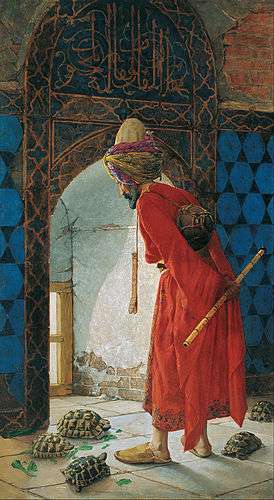
Turkish painting, in the Western sense, developed actively starting from the mid 19th century. The very first painting lessons were scheduled at what is now the Istanbul Technical University (then the Imperial Military Engineering School) in 1793, mostly for technical purposes.[321] In the late 19th century, human figure in the western sense was being established in Turkish painting, especially with Osman Hamdi Bey. Impressionism, among the contemporary trends, appeared later on with Halil Paşa. The young Turkish artists sent to Europe in 1926 came back inspired by contemporary trends such as Fauvism, Cubism and even Expressionism, still very influential in Europe. The later "Group D" of artists led by Abidin Dino, Cemal Tollu, Fikret Mualla, Fahrünnisa Zeid, Bedri Rahmi Eyüboğlu, Adnan Çoker and Burhan Doğançay introduced some trends that had lasted in the West for more than three decades. Other important movements in Turkish painting were the "Yeniler Grubu" (The Newcomers Group) of the late 1930s; the "On'lar Grubu" (Group of Ten) of the 1940s; the "Yeni Dal Grubu" (New Branch Group) of the 1950s; and the "Siyah Kalem Grubu" (Black Pen Group) of the 1960s.[322]

Turkish music and literature are examples of a mix of cultural influences. Interaction between the Ottoman Empire and the Islamic world along with Europe contributed to a blend of Turkic, Islamic and European traditions in modern-day Turkish music and literary arts.[324] Turkish literature was heavily influenced by Persian and Arabic literature during most of the Ottoman era. The Tanzimat reforms introduced previously unknown Western genres, primarily the novel and the short story. Many of the writers in the Tanzimat period wrote in several genres simultaneously: for instance, the poet Nâmık Kemal also wrote the important 1876 novel İntibâh (Awakening), while the journalist Şinasi is noted for writing, in 1860, the first modern Turkish play, the one-act comedy "Şair Evlenmesi" (The Poet's Marriage). Most of the roots of modern Turkish literature were formed between the years 1896 and 1923. Broadly, there were three primary literary movements during this period: the Edebiyyât-ı Cedîde (New Literature) movement; the Fecr-i Âtî (Dawn of the Future) movement; and the Millî Edebiyyât (National Literature) movement. The first radical step of innovation in 20th century Turkish poetry was taken by Nâzım Hikmet, who introduced the free verse style. Another revolution in Turkish poetry came about in 1941 with the Garip Movement. The mix of cultural influences in Turkey is dramatized, for example, in the form of the "new symbols of the clash and interlacing of cultures" enacted in the novels of Orhan Pamuk, recipient of the 2006 Nobel Prize in Literature.[325]
Turkey has a diverse folkloric dance culture. Hora is performed in East Thrace; Zeybek in the Aegean Region, Southern Marmara and East-Central Anatolia Region; Teke in the Western Mediterranean Region; Kaşık Oyunları and Karşılama in West-Central Anatolia, Western Black Sea Region, Southern Marmara Region and Eastern Mediterranean Region; Horon in the Central and Eastern Black Sea Region; Halay in Eastern Anatolia and the Central Anatolia Region; and Bar and Lezginka in the Northeastern Anatolia Region.[326]
Architecture
The architecture of the Seljuk Turks combined the elements and characteristics of the Turkic architecture of Central Asia with those of Persian, Arab, Armenian and Byzantine architecture. The transition from Seljuk architecture to Ottoman architecture is most visible in Bursa, which was the capital of the Ottoman State between 1335 and 1413. Following the Ottoman conquest of Constantinople (Istanbul) in 1453, Ottoman architecture was significantly influenced by Byzantine architecture. Topkapı Palace in Istanbul is one of the most famous examples of classical Ottoman architecture and was the primary residence of the Ottoman Sultans for approximately 400 years.[327] Mimar Sinan (c.1489–1588) was the most important architect of the classical period in Ottoman architecture. He was the chief architect of at least 374 buildings which were constructed in various provinces of the Ottoman Empire in the 16th century.[328]
Since the 18th century, Turkish architecture has been increasingly influenced by European styles, and this can be particularly seen in the Tanzimat era buildings of Istanbul like the Dolmabahçe, Çırağan, Feriye, Beylerbeyi, Küçüksu, Ihlamur and Yıldız palaces, which were all designed by members of the Balyan family of Ottoman court architects.[329] The Ottoman era waterfront houses (yalı) on the Bosphorus also reflect the fusion between classical Ottoman and European architectural styles during the aforementioned period. The First National Architectural Movement (Birinci Ulusal Mimarlık Akımı) in the early 20th century sought to create a new architecture, which was based on motifs from Seljuk and Ottoman architecture. The movement was also labelled Turkish Neoclassical or the National Architectural Renaissance.[330] The leading architects of this movement were Vedat Tek (1873–1942), Mimar Kemaleddin Bey (1870–1927), Arif Hikmet Koyunoğlu (1888–1982) and Giulio Mongeri (1873–1953).[331] Notable buildings from this era are the Grand Post Office in Istanbul (1905–1909), Tayyare Apartments (1919–1922),[332] Istanbul 4th Vakıf Han (1911–1926),[333] State Art and Sculpture Museum (1927–1930),[334] Ethnography Museum of Ankara (1925–1928),[335] the first Ziraat Bank headquarters in Ankara (1925–1929),[336] the first Türkiye İş Bankası headquarters in Ankara (1926–1929),[337] Bebek Mosque,[338] and Kamer Hatun Mosque.[339][340]
Sports
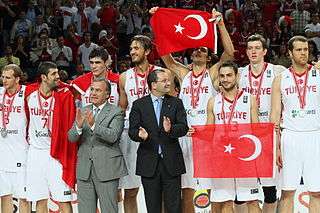
The most popular sport in Turkey is association football (soccer).[341] Galatasaray won the UEFA Cup and UEFA Super Cup in 2000.[342] The Turkish national football team finished 3rd and won the bronze medal at the 2002 FIFA World Cup and at the 2003 FIFA Confederations Cup; while also reaching the semi-finals (finishing 3rd by goals difference) at the UEFA Euro 2008.[343]
Other mainstream sports such as basketball and volleyball are also popular. The Turkish men's national basketball team finished 2nd and won the silver medal at the 2010 FIBA World Championship and at EuroBasket 2001, which were both hosted by Turkey. They also won two gold medals (1987 and 2013), one silver medal (1971) and three bronze medals (1967, 1983 and 2009) at the Mediterranean Games. Turkish basketball club Anadolu Efes S.K. won the 1995–96 FIBA Korać Cup, finished 2nd at the 1992–93 FIBA Saporta Cup, and made it to the Final Four of Euroleague and Suproleague in 2000 and 2001, finishing 3rd on both occasions.[344][345] Another Turkish basketball club, Beşiktaş, won the 2011–12 FIBA EuroChallenge.[346] Galatasaray won the 2015–16 Eurocup, while in the same season, Fenerbahçe finished second in the 2015–16 Euroleague. The Final of the 2013–14 EuroLeague Women basketball championship was played between two Turkish teams, Galatasaray and Fenerbahçe, and won by Galatasaray.[347]
The Turkish women's national volleyball team won the silver medal at the 2003 European Championship, the bronze medal at the 2011 European Championship, and the bronze medal at the 2012 FIVB World Grand Prix. They also won a gold medal (2005), six silver medals (1987, 1991, 1997, 2001, 2009, 2013) and a bronze medal (1993) at the Mediterranean Games.[348] Women's volleyball clubs in Turkey, namely Fenerbahçe, Eczacıbaşı and Vakıfbank, have won numerous European championship titles and medals. Fenerbahçe won the 2010 FIVB Women's Club World Championship and the 2012 CEV Women's Champions League. Representing Europe as the winner of the 2012–13 CEV Women's Champions League, Vakıfbank also became the world champion by winning the 2013 FIVB Women's Club World Championship.[349][350][351]
The traditional Turkish national sport has been yağlı güreş (oiled wrestling) since Ottoman times.[352] Edirne has hosted the annual Kırkpınar oiled wrestling tournament since 1361.[353] International wrestling styles governed by FILA such as Freestyle wrestling and Greco-Roman wrestling are also popular, with many European, World and Olympic championship titles won by Turkish wrestlers both individually and as a national team.[354]
Cuisine

Turkish cuisine is regarded as one of the most prominent in the world, its popularity is largely owed to the cultural influences of the Ottoman Empire and partly because of its major tourism industry. It is largely the heritage of Ottoman cuisine, which can be described as a fusion and refinement of Central Asian, Caucasian, Middle Eastern, Mediterranean and Balkan cuisines.[357]
The country's position between the East and the Mediterranean Sea helped the Turks gain complete control of major trade routes, and an ideal environment allowed plants and animals to flourish. Turkish cuisine was well established by the mid-1400s, the beginning of the Ottoman Empire's six hundred-year reign. Yogurt salads, fish in olive oil, and stuffed and wrapped vegetables became Turkish staples. The empire, eventually spanning from Austria to northern Africa, used its land and water routes to import exotic ingredients from all over the world. By the end of the 16th century, the Ottoman court housed over 1,400 live-in cooks and passed laws regulating the freshness of food. Since the fall of the empire in World War I (1914–1918) and the establishment of the Turkish Republic in 1923, foreign food such as French hollandaise sauce and western fast food have made their way into the modern Turkish diet.[358]
Media
Hundreds of television channels, thousands of local and national radio stations, several dozen newspapers, a productive and profitable national cinema and a rapid growth of broadband internet use all make up a very vibrant media industry in Turkey.[359] In 2003 a total of 257 television stations and 1,100 radio stations were licensed to operate, and others operated without licenses. Of those licensed, 16 television and 36 radio stations reached national audiences.[360] The majority of the audiences are shared among public broadcaster TRT and the network-style channels such as Kanal D, Show TV, ATV and Star TV. The broadcast media have a very high penetration as satellite dishes and cable systems are widely available.[360] The Radio and Television Supreme Council (RTÜK) is the government body overseeing the broadcast media.[360] By circulation, the most popular newspapers are Posta, Hürriyet, Sözcü, Sabah and Habertürk.[361] Turkish television dramas are increasingly becoming popular beyond Turkey's borders and are among the country's most vital exports, both in terms of profit and public relations.[362] After sweeping the Middle East's television market over the past decade, Turkish shows have aired in more than a dozen South and Central American countries in 2016.[363] Freedom House lists Turkey's media as not free.[113]
See also
- Turkey Home
- Index of Turkey-related articles
- List of Turkic dynasties and countries
- Outline of Turkey
- Provinces of Turkey
Notes
- ↑ as stated in the Treaty of Lausanne
References
- ↑ Lewis, M. Paul (ed.) (2016). "Turkey". Ethnologue: Languages of the World. SIL International. Retrieved 2016-10-27.
- ↑ "Population by Years, Age Group and Sex, Census of Population - ABPRS (2015)". Turkish Statistical Institute. Retrieved 10 November 2016.
- ↑ "Annual growth rate and population density of provinces by years, 2007-2015". Turkish Statistical Institute. Retrieved 10 November 2016.
- 1 2 3 4 "Report for Selected Countries and Subjects". IMF World Economic Outlook Database, April 2016. 24 April 2016. Retrieved 24 April 2016.
- ↑ "Gini Coefficient by Equivalised Household Disposable Income". Turkstat. Retrieved 16 May 2015.
- ↑ "2015 Human Development Report" (PDF). 15 December 2015. Retrieved 15 December 2015.
- ↑ Zdanowski, Jerzy (2014). Middle Eastern Societies in the 20th Century. Cambridge Scholars Publishing. p. 11. ISBN 978-1443869591.
The Republic of Turkey lies on two continents. Approximately 97% of it is in Asia, in the geographical regions known as Asia Minor and the Armenian Upland. The remaining 3% of Turkey is in Europe, on the Balkan Peninsula.
- 1 2 3 4 5 6 7 8 9 10 "Turkey". The World Factbook, Central Intelligence Agency. Retrieved 13 October 2016.
- ↑ National Geographic Atlas of the World (7th ed.). Washington, D.C.: National Geographic. 1999. ISBN 0-7922-7528-4. "Europe" (pp. 68–69); "Asia" (pp. 90–91): "A commonly accepted division between Asia and Europe ... is formed by the Ural Mountains, Ural River, Caspian Sea, Caucasus Mountains, and the Black Sea with its outlets, the Bosporus and Dardanelles."
- ↑ "The Political and Strategic Importance of Turkey". Bulletin of International News. Royal Institute of International Affairs. 4 November 1939. pp. 3–11. JSTOR 25642612.
- ↑ "Economic and Strategic Role of Turkey" (PDF). House of Lords, U.K. Parliament. 13 January 2011.
- ↑ Stiner, Mary C.; Kuhn, Steven L.; Güleç, Erksin. "Early Upper Paleolithic shell beads at Üçağızlı Cave I (Turkey): Technology and the socioeconomic context of ornament life-histories". Journal of Human Evolution. 64 (5): 380–398. doi:10.1016/j.jhevol.2013.01.008. ISSN 0047-2484. PMID 23481346.
- ↑ Douglas Arthur Howard. The History of Turkey. Greenwood Publishing Group. pp. xiv–xx. ISBN 978-0-313-30708-9. Retrieved 2 April 2013.
- 1 2 3 4 Sharon R. Steadman; Gregory McMahon (15 September 2011). The Oxford Handbook of Ancient Anatolia: (10,000–323 BC). Oxford University Press. pp. 3–11, 37. ISBN 978-0-19-537614-2. Retrieved 23 March 2013.
- 1 2 Casson, Lionel (1977). "The Thracians" (PDF). The Metropolitan Museum of Art Bulletin. 35 (1): 2–6. doi:10.2307/3258667.
- 1 2 David Noel Freedman; Allen C. Myers; Astrid Biles Beck (2000). Eerdmans Dictionary of the Bible. Wm. B. Eerdmans Publishing. p. 61. ISBN 978-0-8028-2400-4. Retrieved 24 March 2013.
- ↑ Metz, Helen Chapin, ed. (1996). "Turkish Origins". Turkey: A Country Study. Area handbook series (fifth ed.). Washington D.C.: United States Government Publishing Office for the Federal Research Division of the Library of Congress. ISBN 0-8444-0864-6. LCCN 95049612.
- ↑ Mehmet Fuat Köprülü&Gary Leiser. The origins of the Ottoman Empire. p. 33.
- 1 2 "Ottoman/Turkish Visions of the Nation, 1860–1950". Retrieved 18 February 2015.
- ↑ Schaller, Dominik J; Zimmerer, Jürgen (2008). "Late Ottoman genocides: the dissolution of the Ottoman Empire and Young Turkish population and extermination policies – introduction". Journal of Genocide Research 10 (1): 7–14. doi:10.1080/14623520801950820
- ↑ Roderic H. Davison; Review "From Paris to Sèvres: The Partition of the Ottoman Empire at the Peace Conference of 1919–1920" by Paul C. Helmreich in Slavic Review, Vol. 34, No. 1 (Mar. 1975), pp. 186–187
- ↑ "Turkey, Mustafa Kemal and the Turkish War of Independence, 1919–23". Encyclopædia Britannica. 2007. Retrieved 2007-10-29.
- 1 2 3 4 "Toplumsal Yapı Araştırması 2006" (PDF). KONDA Research and Consultancy. 2006. Retrieved 21 February 2015.
- ↑ Sandra Mackey (2003). The Reckoning: Iraq and the Legacy of Saddam Hussein. Norton. p. 350. ISBN 978-0-393-32428-0.
- 1 2 3 "Chronology of Turkey-EU relations". Turkish Secretariat of European Union Affairs. Archived from the original on 15 May 2007. Retrieved 30 October 2006.
- ↑ "The Political Economy of Regional Power: Turkey" (PDF). giga-hamburg.de. Retrieved 18 February 2015.
- ↑ "Turkey: From regional to global player". dw.de. Retrieved 18 February 2015.
- ↑ "International Organisations". mfa.gov.tr. Retrieved 10 September 2014.
- ↑ "Theoretical Analysis of Turkey as a Regional Power" (PDF). web.isanet.org. Retrieved 18 February 2015.
- ↑ Scharlipp, Wolfgang (2000). An Introduction to the Old Turkish Runic Inscriptions. Verlag auf dem Ruffel., Engelschoff. ISBN 3-933847-00-1, 9783933847003.
- ↑ Harper, Douglas (2001). "Turkey". Online Etymology Dictionary. Retrieved 16 June 2013.
- ↑ Jenkins, Romilly James Heald (1967). De Administrando Imperio by Constantine VII Porphyrogenitus. Corpus fontium historiae Byzantinae (New, revised ed.). Washington, D.C.: Dumbarton Oaks Center for Byzantine Studies. p. 65. ISBN 0-88402-021-5. Retrieved 28 August 2013. According to Constantine Porphyrogenitus, writing in his De Administrando Imperio (ca. 950 AD) "Patzinakia, the Pecheneg realm, stretches west as far as the Siret River (or even the Eastern Carpathian Mountains), and is four days distant from Tourkia (i.e. Hungary)."
- ↑ Günter Prinzing; Maciej Salamon (1999). Byzanz und Ostmitteleuropa 950–1453: Beiträge zu einer table-ronde des XIX. International Congress of Byzantine Studies, Copenhagen 1996. Otto Harrassowitz Verlag. p. 46. ISBN 978-3-447-04146-1. Retrieved 9 February 2013.
- ↑ Henry Hoyle Howorth (2008). History of the Mongols from the 9th to the 19th Century: The So-called Tartars of Russia and Central Asia. Cosimo, Inc. p. 3. ISBN 978-1-60520-134-4. Retrieved 15 June 2013.
- ↑ Öztürk, Özhan (2011). "Pontus: Antik Çağ'dan Günümüze Karadeniz'in Etnik ve Siyasi Tarihi". Ankara: Genesis Yayınları. p. 364.
... Greek term Tourkoi first used for the Khazars in 568 AD. In addition in "De Administrando Imperio" Hungarians call Tourkoi too once known as Sabiroi ...
- ↑ Imber, Colin. "The Ottoman Empire, 1300–1650, The Structure of Power" (PDF). fatih.edu.tr. Retrieved 9 August 2014.
- ↑ "Megalithomania – Origins of Civilization Gobekli Tepe tour".
- ↑ "Hattusha: the Hittite Capital". whc.unesco.org. Retrieved 12 June 2014.
- ↑ "The Position of Anatolian". Archived from the original (PDF) on 5 May 2013. Retrieved 4 May 2013.
- ↑ Balter, Michael (27 February 2004). "Search for the Indo-Europeans: Were Kurgan horsemen or Anatolian farmers responsible for creating and spreading the world's most far-flung language family?". Science. 303 (5662): 1323. doi:10.1126/science.303.5662.1323. PMID 14988549.
- ↑ "The World's First Temple". Archaeology magazine. Nov–Dec 2008. p. 23.
- ↑ "Çatalhöyük added to UNESCO World Heritage List". Global Heritage Fund. 3 July 2012. Retrieved 9 February 2013.
- ↑ "Troy". ancient.eu. Retrieved 9 August 2014.
- ↑ "Ziyaret Tepe – Turkey Archaeological Dig Site". uakron.edu. Retrieved 4 September 2010.
- ↑ "Assyrian Identity in Ancient Times And Today'" (PDF). Retrieved 4 September 2010.
- ↑ Zimansky, Paul. Urartian Material Culture As State Assemblage: An Anomaly in the Archaeology of Empire. p. 103.
- ↑ The Metropolitan Museum of Art, New York (October 2000). "Anatolia and the Caucasus, 2000–1000 B.C. in Timeline of Art History.". New York: The Metropolitan Museum of Art. Archived from the original on 10 September 2006. Retrieved 21 December 2006.
- ↑ Roux, Georges. Ancient Iraq. p. 314.
- ↑ D. M. Lewis; John Boardman (1994). The Cambridge Ancient History. Cambridge University Press. p. 444. ISBN 978-0-521-23348-4. Retrieved 7 April 2013.
- ↑ Joseph Roisman,Ian Worthington. "A companion to Ancient Macedonia" John Wiley & Sons, 2011. ISBN 144435163X pp 135–138, p 343
- ↑ Hooker, Richard (6 June 1999). "Ancient Greece: The Persian Wars". Washington State University, Washington, United States. Archived from the original on 20 November 2010. Retrieved 22 December 2006.
- ↑ The Metropolitan Museum of Art, New York (October 2000). "Anatolia and the Caucasus (Asia Minor), 1000 B.C. – 1 A.D. in Timeline of Art History.". New York: The Metropolitan Museum of Art. Archived from the original on 14 December 2006. Retrieved 21 December 2006.
- ↑ Theo van den Hout (27 October 2011). The Elements of Hittite. Cambridge University Press. p. 1. ISBN 978-1-139-50178-1. Retrieved 24 March 2013.
- ↑ Daniel C. Waugh (2004). "Constantinople/Istanbul". University of Washington, Seattle, Washington. Retrieved 26 December 2006.
- ↑ "Anadolu Selçuklu Devleti". turktarihim.com. Retrieved 21 July 2014.
- ↑ Wink, Andre (1990). Al Hind: The Making of the Indo Islamic World, Vol. 1, Early Medieval India and the Expansion of Islam, 7th–11th Centuries. Brill Academic Publishers. p. 21. ISBN 90-04-09249-8.
- ↑ "THE SELJUK TURKS". peter.mackenzie.org. Retrieved 9 August 2014.
- ↑ Rafis Abazov (2009). Culture and Customs of Turkey. Greenwood Publishing Group. p. 1071. ISBN 978-0-313-34215-8. Retrieved 25 March 2013.
- ↑ Craig S. Davis. "The Middle East For Dummies" ISBN 0764554832 p 66
- ↑ Thomas Spencer Baynes. "The Encyclopædia Britannica: Latest Edition. A Dictionary of Arts, Sciences and General Literature, Volume 23". Werner, 1902
- ↑ Emine Fetvacı. "Picturing History at the Ottoman Court" p 18
- 1 2 Kinross, Patrick (1977). The Ottoman Centuries: The Rise and Fall of the Turkish Empire. Morrow. pp. 28–30. ISBN 0-688-03093-9.
- ↑ Simons, Marlise (1993-08-22). "Center of Ottoman Power". New York Times. Retrieved 2009-06-04.
- ↑ "Dolmabahce Palace". dolmabahcepalace.com. Retrieved 4 August 2014.
- ↑ Faroqhi, Suraiya (1994). "Crisis and Change, 1590-1699". In İnalcık, Halil; Donald Quataert. An Economic and Social History of the Ottoman Empire, 1300-1914. 2. Cambridge University Press. p. 507. ISBN 0-521-57456-0.
- ↑ Stanford J. Shaw (29 October 1976). History of the Ottoman Empire and Modern Turkey. 1. Cambridge University Press. p. 213. ISBN 978-0-521-29163-7. Retrieved 15 June 2013.
- ↑ Kirk, George E. (2008). A Short History of the Middle East. Brill Academic Publishers. p. 58. ISBN 1-4437-2568-4.
- ↑ Niall Ferguson (2 January 2008). "An Ottoman warning for indebted America". Financial Times. Retrieved 5 September 2016.
- ↑ Todorova, Maria (18 March 2009). Imagining the Balkans. Oxford University Press. p. 175. ISBN 978-0-19-972838-1. Retrieved 15 June 2013.
- ↑ Mann, Michael (2005). The Dark Side of Democracy: Explaining Ethnic Cleansing. Cambridge University Press. p. 118. ISBN 978-0-521-53854-1. Retrieved 28 February 2013.
- ↑ "Collapse of the Ottoman Empire, 1918–1920". nzhistory.net.nz. Retrieved 9 August 2014.
- ↑ "Armenian Genocide". Encyclopædia Britannica. Retrieved 23 April 2015.
- ↑ "Fact Sheet: Armenian Genocide". University of Michigan. Retrieved 15 July 2010.
- ↑ Freedman, Jeri (2009). The Armenian genocide (1st ed.). New York: Rosen Pub. Group. ISBN 1-4042-1825-4.
- ↑ Totten, Samuel, Paul Robert Bartrop, Steven L. Jacobs (eds.) Dictionary of Genocide. Greenwood Publishing Group, 2008, p. 19. ISBN 0-313-34642-9.
- ↑ Raziye Akkoç (15 October 2015). "ECHR: Why Turkey won't talk about the Armenian genocide". The Telegraph. Retrieved 28 May 2016.
- ↑ Donald Bloxham (2005). The Great Game of Genocide: Imperialism, Nationalism, And the Destruction of the Ottoman Armenians. Oxford University Press. p. 150. ISBN 978-0-19-927356-0. Retrieved 9 February 2013.
- ↑ Levene, Mark (Winter 1998). "Creating a Modern 'Zone of Genocide': The Impact of Nation- and State-Formation on Eastern Anatolia, 1878–1923". Holocaust and Genocide Studies. 12 (3): 393–433. doi:10.1093/hgs/12.3.393.
- ↑ Ferguson, Niall (2007). The War of the World: Twentieth-Century Conflict and the Descent of the West. Penguin Group (USA) Incorporated. p. 180. ISBN 978-0-14-311239-6.
- 1 2 Mango, Andrew (2000). Atatürk: The Biography of the Founder of Modern Turkey. Overlook. p. lxxviii. ISBN 1-58567-011-1.
- ↑ Heper, Criss, Metin, Nur Bilge. "Historical Dictionary of Turkey". Scarecrow Press. ISBN 978-0-8108-6281-4.
- ↑ Axiarlis, Evangelia (2014). Political Islam and the Secular State in Turkey: Democracy, Reform and the Justice and Development Party. I.B. Tauris. p. 11.
- ↑ Clogg, Richard (20 June 2002). A Concise History of Greece. Cambridge University Press. p. 101. ISBN 978-0-521-00479-4. Retrieved 9 February 2013.
- ↑ Gerhard Bowering; Patricia Crone; Wadad Kadi; Devin J. Stewart; Muhammad Qasim Zaman; Mahan Mirza (28 November 2012). The Princeton Encyclopedia of Islamic Political Thought. Princeton University Press. p. 49. ISBN 978-1-4008-3855-4. Retrieved 14 August 2013.
Following the revolution, Mustafa Kemal became an important figure in the military ranks of the Ottoman Committee of Union and Progress (CUP) as a protégé ... Although the sultanate had already been abolished in November 1922, the republic was founded in October 1923. ... ambitious reform programme aimed at the creation of a modern, secular state and the construction of a new identity for its citizens.
- ↑ "Growth in United Nations membership (1945–2005)". United Nations. 3 July 2006. Retrieved 30 October 2006.
- ↑ Huston, James A. (1988). Outposts and Allies: U.S. Army Logistics in the Cold War, 1945–1953. Susquehanna University Press. p. 134. ISBN 0-941664-84-8.
- ↑ "Members and partners". OECD. Retrieved 9 August 2014.
- ↑ Uslu, Nasuh (2003). The Cyprus question as an issue of Turkish foreign policy and Turkish-American relations, 1959–2003. Nova Publishers. p. 119. ISBN 978-1-59033-847-6. Retrieved 16 August 2011.
- ↑ "Timeline: Cyprus". BBC. 12 December 2006. Retrieved 25 December 2006.
- ↑ Hale, William Mathew (1994). Turkish Politics and the Military. Routledge, UK. pp. 161, 215, 246. ISBN 0-415-02455-2.
- ↑ Arsu, Sebsem (12 April 2012). "Turkish Military Leaders Held for Role in '97 Coup". The New York Times. Retrieved 11 August 2014.
- ↑ "Turkey's PKK peace plan delayed". BBC. 10 November 2009. Retrieved 6 February 2010.
- ↑ "Still critical". 17 (2). Human Rights Watch. March 2005: 3. Retrieved 2007-09-12.
- ↑ Baser, Bahar (2015). Diasporas and Homeland Conflicts: A Comparative Perspective. Ashgate Publishing. p. 63. ISBN 1472425626.
- ↑ Sebnem Arsu (25 April 2013). "Kurdish Rebel Group to Withdraw From Turkey". The New York Times. Retrieved 29 April 2013.
- ↑ "Murat Karayilan announces PKK withdrawal from Turkey". BBC. 25 April 2013. Retrieved 29 April 2013.
- ↑ "Turkish jets target Kurds in Iraq, Islamic State militants in Syria". Fox News. Retrieved 3 August 2015.
- 1 2 Nas, Tevfik F. (1992). Economics and Politics of Turkish Liberalization. Lehigh University Press. p. 12. ISBN 0-934223-19-X.
- ↑ Mullen, Jethro; Cullinane, Susannah (4 June 2013). "What's driving unrest and protests in Turkey?". CNN. Retrieved 6 June 2013.
- ↑ Cunningham, Erin; Sly, Liz; Karatas, Zeynep (16 July 2016). "Turkey rounds up thousands of suspected participants in coup attempt". The Washington Post. Retrieved 17 July 2016.
- ↑ "General Structure of Turkish Public Administration" (PDF). justice.gov.tr/. Ministry of Justice. Retrieved 14 August 2014.
- ↑ "Turkey Districts". Retrieved 9 August 2014.
- ↑ Çarkoğlu, Ali (2004). Religion and Politics in Turkey. Routledge, UK. ISBN 0-415-34831-5.
- ↑ Turkish Directorate General of Press and Information (17 October 2001). "Turkish Constitution". Turkish Prime Minister's Office. Archived from the original on 3 February 2007. Retrieved 16 December 2006.
- ↑ "Euro court backs Turkey Islamist ban". BBC. 31 July 2001. Retrieved 14 December 2006.
- ↑ "Turkey's Kurd party ban criticised". BBC. 14 March 2003. Retrieved 14 December 2006.
- ↑ Turkish Directorate General of Press and Information (24 August 2004). "Political Structure of Turkey". Turkish Prime Minister's Office. Archived from the original on 3 February 2007. Retrieved 14 December 2006.
- 1 2 3 Kate Fleet; Suraiya Faroqhi; Reşat Kasaba (17 April 2008). The Cambridge History of Turkey. Cambridge University Press. pp. 357–358. ISBN 978-0-521-62096-3. Retrieved 13 June 2013.
- ↑ "Human rights in Turkey: still a long way to go to meet accession criteria". European Parliament Human Rights committee. 26 October 2010. Retrieved 9 February 2013.
- 1 2 3 Turkey's Press Freedom Crisis. "Turkey's Press Freedom Crisis". Committee to Protect Journalists. Retrieved 9 February 2013.
- ↑ "Russia, China and Turkey top yearly list of music freedom violations". freemuse.org. Retrieved 19 February 2015.
- ↑ "Seven journalists arrested in Turkey". The Guardian. 4 March 2011. Retrieved 11 June 2013.
- 1 2 3 "Turkey". freedomhouse.org. Retrieved 29 January 2015.
- ↑ "Rights violations, terror ops threaten Turkey's democratic institutions: PACE". Hurriyet Daily News. 2016-06-23. Retrieved 2016-06-23.
- ↑ "Turkish Legal System". mymerhaba.com/. Retrieved 14 August 2014.
- 1 2 "THE JUDICIAL SYSTEM OF TURKEY" (PDF). uhdigm.adalet.gov.tr/. Ministry of Justice. Retrieved 14 August 2014.
- ↑ "General Directorate of Judicial Records". adlisicil.adalet.gov. Retrieved 25 November 2016.
- 1 2 "European Commission: Turkey 2015 report" (PDF). European Commission. 2015-11-10. Retrieved 2016-07-06.
- ↑ "European Parliament resolution of 14 April 2016 on the 2015 report on Turkey". European Parliament. 2016-04-14. Retrieved 2016-07-06.
- ↑ "Turkey's institutions are failing to comply with good governance principles and combat corruption". Transparency International. 2016-04-07. Retrieved 2016-07-06.
- ↑ "As ISIS attacks mount, Turkey steps up its war on free speech". Newsweek. 2016-07-06. Retrieved 2016-07-06.
- ↑ "The United Nations Organization and Turkey". mfa.gov.tr. Retrieved 12 June 2014.
- 1 2 "Turkey's Relations with the Organization for Economic Co-operation and Development (OECD)". mfa.gov.tr. Retrieved 12 June 2014.
- ↑ "The Republic of Turkey and The Organization of The Islamic Conference". mfa.gov.tr. Retrieved 12 June 2014.
- ↑ "The Organization for Security and Co-operation in Europe (OSCE)". mfa.gov.tr. Retrieved 12 June 2014.
- ↑ "Turkey's relations with the Economic Cooperation Organization (ECO)". mfa.gov.tr. Retrieved 12 June 2014.
- ↑ "The Black Sea Economic Cooperation Organization (BSEC)". mfa.gov.tr. Retrieved 12 June 2014.
- ↑ "D8". mfa.gov.tr. Retrieved 12 June 2014.
- 1 2 "G-20". mfa.gov.tr. Retrieved 12 June 2014.
- ↑ "Türkiye'nin üyeliği kabul edildi". Hürriyet Daily News. 17 October 2008. Retrieved 1 November 2010.
- ↑ Mardell, Mark (11 December 2006). "Turkey's EU membership bid stalls". BBC. Retrieved 17 December 2006.
- ↑ "False Friends. Why the United States Is Getting Tough With Turkey". foreignaffairs.com. Retrieved 6 April 2015.
- ↑ "Turkey: Background and U.S. Relations" (PDF). fas.org. Retrieved 6 April 2015.
- ↑ Ziya Öniş, ŞuhnazYılmaz. "Turkey-EU-US Triangle in Perspective: Transformation or Continuity?" (PDF). istanbul2004.ku.edu.tr/. Retrieved 4 August 2014.
- ↑ Mitrovic, Marija. "Turkish Foreign Policy towards the Balkans" (PDF). edoc.hu-berlin.de. Retrieved 9 August 2014.
- ↑ İdris Bal (2004). Turkish Foreign Policy in Post Cold War Era. Universal-Publishers. p. 269. ISBN 978-1-58112-423-1. Retrieved 15 June 2013.
- ↑ Elanchenny, Susae (2010). Breaking the Ice The Role of Civil Society and Media in Turkey-Armenia Relations An Evaluation of the 'Dialogue-Building between Turkey and Armenia' Project. Istanbul: Istanbul Kültür University. p. 9. ISBN 605-4233-80-7.
- ↑ Taşpınar, Ömer (September 2008). "Turkey's Middle East Policies: Between Neo-Ottomanism and Kemalism". Carnegie Endowment for International Peace. Retrieved 5 June 2010.
- ↑ Murinson, Alexander (December 2009). Turkey's Entente with Israel and Azerbaijan: State Identity and Security in the Middle East and Caucasus (Routledge Studies in Middle Eastern Politics). Routledge. p. 119. ISBN 0-415-77892-1.
- ↑ "Syria ratchets up tension with Turkey – warning it of dangers of rebel support". Euronews. 4 October 2013.
- ↑ "Turkey, Egypt recall envoys in wake of violence". Bloomberg. 16 August 2013.
- ↑ Yaşar Yakış (2014-09-29). "On Relations between Turkey and Egypt". Turkish Weekly. Retrieved 2014-11-19.
- ↑ "Israel and Turkey end rift over Gaza flotilla killings". BBC. 2016-06-27. Retrieved 2016-06-27.
- ↑ "Greece, Egypt, Cyprus urge Turkey to quit gas search off island". Reuters. 2014-10-29. Retrieved 2014-11-19.
- ↑ "Egypt, Greece, Cyprus pledge to boost energy cooperation". Reuters. 2014-11-08. Retrieved 2014-11-19.
- ↑ "Policy of Zero Problems with our Neighbors". Turkish Ministry of Foreign Affairs. Retrieved 2014-11-19.
- ↑ Piotr Zalewsky (2013-08-22). "How Turkey Went From 'Zero Problems' to Zero Friends". Foreign Policy. Retrieved 2014-11-19.
- ↑ Mark Lowen (2014-11-20). "Erdogan's 'New Turkey' drifts towards isolation". BBC. Retrieved 2014-11-22.
- ↑ Gareth Porter (28 May 2015). "Gulf allies and 'Army of Conquest'". Al-Ahram Weekly.
- ↑ "Syria: Saudi-Turkish alliance backs 'Conquest Army' rebels to defeat Bashar al-Assad". International Business Times. 7 May 2015.
- ↑ Richmond, Oliver P. (1998). Mediating in Cyprus: The Cypriot Communities and the United Nations. Psychology Press. p. 260. ISBN 978-0-7146-4877-4. Retrieved 9 February 2013.
- ↑ "Contribution of Turkish Armed Forces to Peace Support Operations". tsk.tr. Turkish Armed Forces. Retrieved 3 August 2014.
- ↑ "Enter the EU Battle Groups" (PDF). Chaillot Paper no.97. European Union Institute for Security Studies. February 2007. p. 88.
- ↑ "Turkey's Relations with NATO". mfa.gov.tr. Retrieved 12 June 2014.
- 1 2 Turkish General Staff (2006). "Turkish Armed Forces Defense Organization". Turkish Armed Forces. Archived from the original on 18 February 2009. Retrieved 15 December 2006.
- ↑ "Financial and Economic Data Relating to NATO Defence" (PDF). NATO. 13 April 2012. Retrieved 16 June 2013.
- ↑ "Der Spiegel: Foreign Minister Wants US Nukes out of Germany (10 April 2009)". Der Spiegel. 30 March 2009. Retrieved 1 November 2010.
- ↑ Hans M. Kristensen. "NRDC: U.S. Nuclear Weapons in Europe" (PDF). Natural Resources Defense Council, 2005. Retrieved 1 November 2010.
- ↑ United Nations High Commissioner for Refugees (UNHCR), Directorate for Movements of Persons, Migration and Consular Affairs – Asylum and Migration Division (July 2001). "Turkey/Military service" (PDF). UNHCR. Archived from the original (PDF) on 22 November 2006. Retrieved 27 December 2006.
- ↑ "EBCO: European Bureau for Conscientious Objection". Ebco-beoc.eu. Retrieved 4 September 2010.
- ↑ Immerfall, Stefan (1 August 2009). Handbook of European Societies: Social Transformations in the 21st Century. Springer. p. 417. ISBN 978-0-387-88198-0. Retrieved 9 August 2011.
- ↑ Metz, Helen Chapin, ed. (1996). "Geography". Turkey: A Country Study. Area handbook series (fifth ed.). Washington D.C.: United States Government Publishing Office for the Federal Research Division of the Library of Congress. ISBN 0-8444-0864-6. LCCN 95049612.
- 1 2 US Library of Congress. "Geography of Turkey". US Library of Congress. Retrieved 13 December 2006.
- ↑ "UN Demographic Yearbook" (PDF). Retrieved 1 November 2010.
- 1 2 "Geography of Turkey". Turkish Ministry of Tourism. 2005. Retrieved 13 December 2006.
- 1 2 "Lake Van". britannica.com. Retrieved 18 February 2015.
- ↑ "Mount Ararat". britannica.com. Retrieved 18 February 2015.
- ↑ "Biodiversity in Turkey". Retrieved 9 August 2014.
- ↑ "Turkey's flora and fauna". allaboutturkey.com. Retrieved 12 June 2014.
- ↑ Couzens, Dominic (2008). Top 100 Birding Sites of the World. University of California Press. pp. 73–75. ISBN 978-0-520-25932-4.
- ↑ "Pontic Mountains and highlands". Retrieved 9 August 2014.
- ↑ Blunt, Wilfrid. Tulipomania. p. 7.
- ↑ E. S. Forster (trans. et ed.), The Turkish Letters of Ogier Ghiselin de Busbecq (Oxford, 1927).
- ↑ "Statistics". milliparklar.gov.tr. Ministry of Forest and Water – General Directorare of Nature Conservation and National Parks. Retrieved 12 June 2014.
- ↑ "Specific Animals of Turkey". gateofturkey.com. Retrieved 12 June 2014.
- ↑ Ertüzün, M. (2006). The last Anatolian Panther.
- ↑ Khorozyan, I. (2008). "Panthera pardus ssp. saxicolor". IUCN Red List of Threatened Species. Version 2014.3. International Union for Conservation of Nature.
- 1 2 Can, O. E. (2004). Status, conservation and management of large carnivores in Turkey. Convention on the Conservation of European Wildlife and Natural Habitats. Standing Committee, 24th meeting, 29 November-3 December 2004, Strasbourg.
- ↑ "Diyarbakır'da öldürülen leopar İran Parsı çıktı".
- ↑ Üstay, A.H. (1990). Hunting in Turkey. BBA, Istanbul.
- 1 2 3 4 5 6 7 8 9 10 11 12 13 14 15 "Climate of Turkey" (PDF). General Directorate of Meteorology. Retrieved 24 January 2014.
- ↑ "Istanbul remains motoring power of Turkey's economy". hurriyetdailynews.com. Retrieved 13 June 2014.
- ↑ "Gross Domestic Product 2015, PPP. (Last revised on 22 July 2016.)" (PDF). The World Bank: World Development Indicators Database. Retrieved 2016-08-31.
- ↑ "Gross Domestic Product 2015, Nominal. (Last revised on 22 July 2016.)" (PDF). The World Bank: World Development Indicators Database. Retrieved 2016-08-31.
- ↑ Bartolomiej Kaminski; Francis Ng (1 May 2006). "Turkey's evolving trade integration into Pan-European markets" (PDF). World Bank. p. 3. Retrieved 27 December 2006.
- ↑ "2015 Production Statistics". Organisation Internationale des Constructeurs d'Automobiles. Retrieved 31 August 2016.
- 1 2 "Shipbuilding Industry in Turkey". Ministry of Economy. 2012. Archived from the original (PDF) on 10 February 2013.
- 1 2 3 "The Shipbuilding Industry in Turkey" (PDF). OECD. September 2011.
- ↑ "About Best-Selling Home Appliance Brand Beko UK". Retrieved 9 August 2014.
- ↑ "Beko Avrupa'da üçüncülüğe oynuyor". Retrieved 9 August 2014.
- ↑ "The Unknown TV Giant – Businessweek". Retrieved 9 August 2014.
- ↑ "Turkey: Agriculture and Rural Development" (PDF). Retrieved 9 December 2011.
- ↑ Turkish Statistical Institute (27 February 2006). "The result of Income Distribution". Turkish Statistical Institute. Archived from the original on 14 October 2006. Retrieved 11 December 2006.
- ↑ "No woman, no growth". Hürriyet Daily News. Retrieved 8 June 2013.
- ↑ "Religious Women in Turkey Have Been Left Out of Emancipation Movement". The New York Times. 23 May 2013. Retrieved 8 June 2013.
- ↑ "M&A Encumbered Risks Damping Hot Money Bond Party: Turkey Credit". Bloomberg L.P. 18 February 2013. Retrieved 8 June 2013.
- ↑ "UPDATE 4-Turkey regains investment grade rating after long wait". Reuters. Retrieved 17 November 2012.
- ↑ Daren Butler (17 May 2013). "UPDATE 1-Turkey hails new investment grading but worries about money flows". Reuters. Retrieved 17 May 2013.
- ↑ Ye Xie; Selcuk Gokoluk (17 May 2013). "Turkey Raised to Investment Grade by Moody's on Debt Cuts". Bloomberg L.P. Retrieved 18 May 2013.
- ↑ "Turkish quake hits shaky economy". BBC. 17 August 1999. Retrieved 12 December 2006.
- ↑ "'Worst over' for Turkey". BBC. 4 February 2002. Retrieved 12 December 2006.
- ↑ "Turkey Labor Market Study" (PDF). World Bank. 2005. Retrieved 10 December 2006.
- ↑ OECD (14 November 2002). Turkey 2002: Crucial Support for Economic Recovery. OECD Publishing. p. 23. ISBN 978-92-64-17601-0. Retrieved 15 June 2013.
- ↑ "Data and Statistics for Turkey". World Bank. 2005. Retrieved 10 December 2006.
- ↑ Madslien, Jorn (2 November 2006). "Robust economy raises Turkey's hopes". BBC. Retrieved 12 December 2006.
- ↑ "General government net debt". World Economic Outlook Database, April 2013. IMF.
- ↑ "Growth and economic crises in Turkey: leaving behind a turbulent past?" (PDF). Economic Papers 386. Directorate-General for Economic and Financial Affairs of the European Commission. October 2009. p. 10.
- ↑ "GDP per capita in PPS". Eurostat. Retrieved 8 May 2013.
- ↑ "Turkey knocks six zeros off lira". BBC. 31 December 2004. Retrieved 20 July 2008.
- ↑ "UNWTO Tourism Highlights, 2014 Edition" (PDF). World Tourism Organization. 2013. Retrieved 11 August 2014.
- ↑ "Tourism Statistics 2012". turkstat.gov.tr/. TurkStat. Retrieved 4 August 2014.
- ↑ "Turkey – UNESCO World Heritage Centre". Retrieved 9 August 2014.
- ↑ "UNESCO official page". whc.unesco.org. Retrieved 2 July 2014.
- ↑ "THE SEVEN WONDERS OF THE WORLD". historyworld.net. Retrieved 2 July 2014.
- ↑ "Capadocia" (PDF).
- 1 2 "Turkish Airlines is named the Best Airline in Europe at the 2012 World Airline Awards held at Farnborough Air Show". Skytrax. 12 July 2012. Retrieved 25 April 2013.
- 1 2 "Turkish Airlines named best airline in Europe for fifth year in a row – BUSINESS".
- 1 2 "Turkish Airlines: International Flight Destinations". Turkish Airlines. Retrieved 22 June 2016.
- ↑ "Bosphorus Bridge, TURKEY". g20.org.tr. Retrieved 2016-06-26.
- ↑ "The Story of the First Bosphorus Bridge – short film and talk". t-vine.com. 2016-05-13. Retrieved 2016-06-26.
- ↑ "CIA World Factbook: Turkey". Retrieved 2014-11-17.
- ↑ "Study in Turkey: International Airports in Turkey". Retrieved 2014-11-17.
- ↑ "Year to date Passenger Traffic". ACI. 2014-09-25. Retrieved 2014-09-25.
- ↑ "It will be the biggest airport of the world". 2013-01-24. Retrieved 2013-01-24.
- ↑ "Istanbul's New Erdoğan-Backed Airport to Be Named After... Erdoğan". 14 August 2014.
- ↑ Gianluca Mezzofiore. "Erdogan Airport: Istanbul's Super Hub 'to be Named After Turkey's President-Elect'". International Business Times UK.
- ↑ http://www.worldairlineawards.com/Awards_2014/europe.htm
- ↑ "Yol Ağı Bilgileri". Karayolları Genel Müdürlüğü. Retrieved 9 August 2014.
- 1 2 "CIA World Factbook: Turkey". Cia.gov. Retrieved 2011-08-29.
- 1 2 "DÜNYADA VE TÜRKİYEDE HIZLI TREN". hizlitren.tcdd.gov.tr. Retrieved 12 August 2014.
- ↑ "BAKÜ-T İ FL İ S-CEYHAN BORUHATTI'NDA SON DURUM" (PDF). emreozgur.com. Retrieved 12 August 2014.
- ↑ "Russia to Shift Ukraine Gas Transit to Turkey as EU Cries Foul". Bloomberg. 14 January 2015. Retrieved 15 January 2015.
- 1 2 3 "Turkey invests big in nuclear power". Deutsche Welle. 20 May 2013. Retrieved 8 June 2013.
- 1 2 Lund, J. W.; Freeston, D. H.; Boyd, T. L. (2005). "Direct application of geothermal energy: 2005 Worldwide review". Geothermics. 34 (6): 691–727. doi:10.1016/j.geothermics.2005.09.003.
- 1 2 "INOGATE website". Inogate.org. Retrieved 2011-08-29.
- ↑ "Turkey 'to speed up' nuclear plant plans". hurriyetdailynews.com. Retrieved 18 February 2015.
- ↑ "Europe Internet Usage Stats Facebook Subscribers and Population Statistics". Internetworldstats.com. Retrieved 2012-11-15.
- ↑ Ministry of Environment and Forestry: EU Integrated Environmental Approximation Strategy, 2007, p. 17
- ↑ "Company Profile". tai.com.tr/. Retrieved 13 August 2014.
- ↑ "Who We Are? The Scientific And Technological Research Council Of Turkey". Tubitak.gov. Retrieved 9 August 2014.
- ↑ "Türkiye Bilimler Akademisi". Tuba.gov. Retrieved 9 August 2014.
- ↑ "Turkish Atomic Energy Authority – Mission of TAEK". TAEK. Retrieved 9 August 2014.
- ↑ "Space Launch System Project". Undersecretariat for Defence Industries. Retrieved 2013-12-20.
- ↑ Bekdil, Burak Ege (2013-07-28). "Turkey's Sat-Launcher Plans Raise Concerns". Defense News. Retrieved 2013-12-20.
- ↑ Bekdil, Burak Ege (2013-12-12). "Turkey Spends Big on Innovation". Defense News. Retrieved 2013-12-20.
- ↑ "Turkish professor, Aziz Sancar, part of the team that wins Nobel Chemistry Prize".
- ↑ "Mid-year population estimations, 1927–1985; Mid-year population estimations and projections, 1986–2011". Turkish Statistical Institute. Retrieved 24 May 2013.
- ↑ Edgecomb, Diane; Ahmed, Mohammed M. A.; Özel, Çeto (2007). A fire in my heart: Kurdish tales. Westport CT: Libraries Unlimited. p. xv. ISBN 159158437X.
The outlines of the map of Kurdistan were taken from two sources: first, a map produced by the CIA in 1992 depicting areas with a Kurdish majority [...]
- ↑ "The Results of Address Based Population Registration System, 2011". Turkish Statistical Institute. Retrieved 15 February 2012.
- ↑ Turkish Statistical Institute (2010). "Population statistics in 2009". Turkish Statistical Institute. Retrieved 28 January 2010.
- ↑ Metz, Helen Chapin, ed. (1996). "Population". Turkey: A Country Study. Area handbook series (fifth ed.). Washington D.C.: United States Government Publishing Office for the Federal Research Division of the Library of Congress. ISBN 0-8444-0864-6. LCCN 95049612.
- ↑ Bator, Robert. Daily Life in Ancient and Modern Istanbul. p. 51.
- ↑ Rashed, Tarek; Jürgens, Carsten. Remote Sensing of Urban and Suburban Areas. p. 295.
- ↑ Albayrak, Özlem. "Herkes Türk müdür, Türk mü olmalıdır? – Is everyone Turk or should be Turk?". yenisafak.com. Retrieved 18 June 2014.
- ↑ Extra, Guus; Gorter, Durk (2001). The other languages of Europe: Demographic, Sociolinguistic and Educational Perspectives. Multilingual Matters. ISBN 1-85359-509-8.
- ↑ "Turkey Overview". minorityrights.org.
- 1 2 "Country – Turkey". Joshua Project. Retrieved 27 April 2014.
- ↑ Sandra Mackey , "The reckoning: Iraq and the legacy of Saddam", W.W. Norton and Company, 2002. Excerpt from pg 350: "As much as 25% of Turkey is Kurdish."
- ↑ Watts, Nicole F. (2010). Activists in Office: Kurdish Politics and Protest in Turkey (Studies in Modernity and National Identity). Seattle: University of Washington Press. p. 167. ISBN 978-0-295-99050-7.
- ↑ Amikam Nachmani (2003). Turkey: Facing a New Millenniium : Coping With Intertwined Conflicts. Manchester University Press. pp. 90–. ISBN 978-0-7190-6370-1. Retrieved 5 May 2013.
- ↑ "Turkey Overview". minorityrights.org. Retrieved 27 November 2014.
- ↑ MINORITY RIGHTS AND CULTURAL RIGHTS gov.tr (accessed 7 January 2015).
- ↑ Turkey passes law to allow minority languages on TV ekurd.net
- ↑ "Yaşayan diller ve lehçeler dersini 85 bin öğrenci seçti". hurriyet.com.tr. Hürriyet. Retrieved 25 March 2015.
- ↑ "Trends in International Migrant Stock: The 2013 Revision". esa.un.org. United Nations. Retrieved 14 August 2014.
- ↑ "Turkey spent $7.6 billion hosting 2.2 million Syrian refugees". Reuters. 18 September 2015. Retrieved 24 September 2015.
- ↑ "Turkey spent $7.6 billion hosting 2.2 million Syrian refugees, says deputy PM". Euronews. 18 September 2015. Retrieved 24 September 2015.
- ↑ "Turkey Has Spent Nearly $8 Billion Caring For 2.2 Million Syrian Refugees". The Huffington Post. 18 September 2015. Retrieved 24 September 2015.
- 1 2 3 "Türkiye'nin yüzde 85'i 'anadilim Türkçe' diyor". Milliyet.com.tr. Retrieved 4 November 2012.
- ↑ "Interactive Atlas of the World's Languages in Danger". UNESCO. Retrieved 9 August 2014.
- ↑ "December 2013 address-based calculation of the Turkish Statistical Institute as presented by citypopulation.de".
- ↑ "Turkey". Joshua Project. Retrieved 2015-04-04.
- ↑ Axel Tschentscher. "International Constitutional Law: Turkey Constitution". Servat.unibe.ch. Retrieved 1 November 2010.
- ↑ "Turkey: Islam and Laicism Between the Interests of State, Politics, and Society" (PDF). Peace Research Institute Frankfurt. Retrieved 19 October 2008.
- ↑ Steunebrink, Gerrit; van der Zweerde, Evert (2004). Civil Society, Religion, and the Nation: Modernization in Intercultural Context : Russia, Japan, Turkey. Rodopi. pp. 175–184. ISBN 978-90-420-1665-1. Retrieved 5 June 2013.
- ↑ "Turkey Lifts Longtime Ban on Head Scarves in State Offices". NY Times. 8 October 2013. Retrieved 1 February 2014.
- ↑ "Turkey-lifts-ban-on-headscarves-at-high-schools". news24.com/. Retrieved 3 November 2014.
- ↑ "TURKEY" (PDF). Library of Congress: Federal Research Division. Retrieved 1 November 2010.
- ↑ "Bureau of Democracy, Human rights and Labor: International Religious Freedom Report 2007 – Turkey". State.gov. Retrieved 1 November 2010.
- ↑ "Turkey: International Religious Freedom Report 2007". State.gov. Retrieved 9 August 2011.
- ↑ "World Directory of Minorities and Indigenous Peoples – Turkey : Alevis". refworld.org. Retrieved 22 April 2015.
- ↑ "Caferi İmamlar" (in Turkish). Aksiyon.com.tr. 11 October 2004. Retrieved 4 September 2010.
- ↑ "Sufism". All about Turkey. 20 November 2006. Retrieved 1 November 2010.
- ↑ "Pew Forum on Religious & Public life". pewforum.org/. Retrieved 29 October 2013.
- ↑ http://www.wingia.com/web/files/news/14/file/14.pdf
- ↑ Chapter 2: Religious Commitment
- ↑ "Is Turkey an Islamic or Secular Country?". Seeker Daily. 9 August 2016. Retrieved 5 October 2016.
- ↑ "Blue Mosque". bluemosque.co. Retrieved 12 June 2014.
- ↑ Içduygu, Ahmet; Toktas, Şule; Ali Soner, B. (1 February 2008). "The politics of population in a nation-building process: emigration of non-Muslims from Turkey". Ethnic and Racial Studies. 31 (2): 358–389. doi:10.1080/01419870701491937.
- ↑ "Chapter The refugees question in Greece (1821–1930) in "Θέματα Νεοελληνικής Ιστορίας", ΟΕΔΒ ("Topics from Modern Greek History"). 8th edition". Nikolaos Andriotis. 2008.
- ↑ "'Editors' Introduction: Why a Special Issue?: Disappearing Christians of the Middle East" (PDF). Editors' Introduction. 2001. Retrieved 11 June 2013.
- ↑ "Religions". Central Intelligence Agency. Retrieved 9 February 2013.
- ↑ "Statistics by Country". catholic-hierarchy.org. Retrieved 18 February 2015.
- ↑ "Christen in der islamischen Welt – Aus Politik und Zeitgeschichte" (PDF). 2008. Retrieved 11 June 2013.
- ↑ "Turkish Protestants still face "long path" to religious freedom". christiancentury.org. Retrieved 3 November 2014.
- ↑ "Life, Culture, Religion". Official Tourism Portal of Turkey. 15 April 2009. Archived from the original on 15 April 2009. Retrieved 9 February 2013.
- ↑ William G. Rusch (2013). The Witness of Bartholomew I, Ecumenical Patriarch. Wm. B. Eerdmans Publishing. p. 31. ISBN 978-0-8028-6717-9.
Constantinople has been the seat of an archiepiscopal see since the fourth century; its ruling hierarch has had the title of"Ecumenical Patriarch" ...
- ↑ Erwin Fahlbusch; Geoffrey William Bromiley (2001). The Encyclopedia of Christianity. Wm. B. Eerdmans Publishing. p. 40. ISBN 978-90-04-11695-5.
The Ecumenical Patriarchate of Constantinople is the ranking church within the communion of ... Between the 4th and 15th centuries, the activities of the patriarchate took place within the context of an empire that not only was ...
- ↑ "An Overview of the History of the Jews in Turkey" (PDF). American Sephardi Federation. 2006. Retrieved 11 June 2013.
- ↑ "Turkish Jews – Brief History". science.co.il. Retrieved 11 August 2014.
- ↑ "Independent". Turkish atheist organisation launches petition calling for babies to no longer be automatically registered as Muslim. The Independent. 9 Nov 2015. Retrieved 4 June 2016.
- ↑ Ekin Karaca (3 March 2016). "Being an Atheist in Turkey". www.human.nl. Retrieved 24 June 2016.
- ↑ "Atheists raising their voice in Turkey amid polarized reactions". Daily News. Retrieved 2015-11-12.
- ↑ "History". istanbul.edu.tr. Retrieved 12 June 2014.
- ↑ "Education in Turkey". World Education Services. Retrieved 12 June 2013.
- 1 2 "Turkey's Education Reform Bill Is About Playing Politics With Pedagogy". The New York Times. Retrieved 12 June 2013.
- ↑ "Education at a Glance: OECD Indicators 2012" (PDF). OECD. Retrieved 12 June 2013.
- 1 2 "Improving The Quality And Equity of Basic Education in Turkey Challenges And Options" (PDF). World Bank. 30 June 2011. p. viii. Retrieved 12 June 2013.
- ↑ "National adult literacy rates (15+), youth literacy rates (15–24) and elderly literacy rates (65+)". UNESCO Institute for Statistics.
- ↑ University numbers on the rise in Turkey (Hürriyet Daily News, 4 September 2011)
- ↑ Oxford Business Group (2009). The Report: Turkey 2009. Oxford Business Group. p. 203. ISBN 978-1-902339-13-9. Retrieved 12 June 2013.
- ↑ "Guide for Foreign Students planning Education in Turkey". Retrieved 9 August 2014.
- ↑ "World University Rankings 2012–2013". Times Higher Education. Retrieved 16 June 2013.
- ↑ "Hürriyet: "Sağlığa 76,3 milyar lira harcandı"". Retrieved 9 August 2014.
- 1 2 "Turkish Statistical Institute: Number of medical institutions in Turkey". Retrieved 9 August 2014.
- ↑ "Turkish Statistical Institute: Number of citizens per healthcare personnel in Turkey". Retrieved 9 August 2014.
- ↑ "Population and Development Indicators – Population and Demography". Turkish Statistical Institute. 18 October 2004. Archived from the original on 19 February 2012. Retrieved 28 January 2010.
- ↑ "UNESCO Intangible Cultural Heritage Lists". unesco.org. Retrieved 3 July 2014.
- 1 2 Ibrahim Kaya (2004). Social Theory and Later Modernities: The Turkish Experience. Liverpool University Press. pp. 57–58. ISBN 978-0-85323-898-0. Retrieved 12 June 2013.
- ↑ Royal Academy of Arts (2005). "Turks – A Journey of a Thousand Years: 600–1600". Royal Academy of Arts. Archived from the original on 18 February 2007. Retrieved 12 December 2006.
- ↑ Antoinette Harri; Allison Ohta (1999). 10th International Congress of Turkish Art. Fondation Max Van Berchem. ISBN 978-2-05-101763-3.
The first military training institutions were the Imperial Army Engineering School (Mühendishane-i Berr-i Hümâyun, 1793) and the Imperial School of Military Sciences (Mekteb-i Ulûm-ı Harbiye-i Şahane, 1834). Both schools taught painting to enable cadets to produce topographic layouts and technical drawings to illustrate landscapes ...
- ↑ ""10'LAR' GRUBU", "YENİ DAL GRUBU", "SİYAH KALEM GRUBU"". turkresmi.com. Retrieved 11 August 2014.
- ↑ Erdmann, Kurt (166). Siebenhundert Jahre Orientteppich (1st ed.). Herford: Bussesche Verlagshandlung. p. 149.
- ↑ "OTTOMAN MUSIC". turkishculture.org. Retrieved 18 February 2015.
- ↑ "Pamuk wins Nobel Literature prize". BBC. 12 October 2006. Retrieved 12 December 2006.
- ↑ "TURKISH FOLK DANCES". ncturkishfestival. Retrieved 29 May 2014.
- ↑ Simons, Marlise (1993-08-22). "Center of Ottoman Power". New York Times. Retrieved 2009-06-04.
- ↑ "A list of the buildings designed by Mimar Sinan". Retrieved 9 August 2014.
- ↑ Goodwin, Godfrey (2003). A History of Ottoman Architecture. Thames & Hudson. ISBN 0-500-27429-0.
- ↑ "The Search for Identity: 1st National Architecture Movement". ArchMuseum.org. Retrieved 20 January 2012.
- ↑ "TURKISH ARCHITECTURE IN THE REPUBLICAN PERIOD". archmuseum.org. Retrieved 18 February 2015.
- ↑ "Tayyare Apartment Building". AtelyeMim.com. Retrieved 2 February 2012.
- ↑ "XIX. Yüzyış ve XX. Yüzyıl Başı Eminönü'nde Osmanlı Büro Hanları" (in Turkish). Yıldız Teknik Üniversitesi-Fen Bilimleri Enstitüsü. Retrieved 2013-02-27.
- ↑ "Ankara – State Museum of Painting and Sculpture". Republic of Turkey, Ministry of Culture. Retrieved 2 February 2012.
- ↑ "Ankara: Ethnographical Museum". Republic of Turkey, Ministry of Culture. Retrieved 2 February 2012.
- ↑ "Belge göster".
- ↑ "TÜRKİYE İŞ BANKASI BİNASI". envanter.gov.tr. Retrieved 18 February 2015.
- ↑ "Bebek Mosque". ArchNet.org. Retrieved 2 February 2012.
- ↑ "Kemer Hatun Mosque, Beyoglu, Istanbul" (in Turkish). MimarlikMuzesi.org. Retrieved 2 February 2012.
- ↑ "Mass Housing Development by a Government Agency and the Politics of Urbanization" (PDF). 14th International Planning History Conference submission by Nilüfer Baturayoğlu Yöney and Yıldız Salman, Istanbul Technical University Faculty of Architecture, Turkey. Retrieved 2 February 2012.
- ↑ Burak Sansal (2006). "Sports in Turkey". allaboutturkey.com. Retrieved 13 December 2006.
- ↑ "Galatasaray AŞ". uefa.com. Retrieved 10 August 2014.
- ↑ "Historical Achievements.". tff.org. Retrieved 10 August 2014.
- ↑ "Historic achievements of the Efes Pilsen Basketball Team". Anadolu Efes Spor Kulübü. Archived from the original on 3 May 2008. Retrieved 9 February 2013.
- ↑ "Anadolu Efes S.K.: Our successes". Retrieved 9 August 2014.
- ↑ "2012 Year In Review: EuroChallenge". fibaeurope.com. Retrieved 10 August 2014.
- ↑ "Galatasaray Lift EuroLeague Women Title". fibaeurope.com. Retrieved 10 August 2014.
- ↑ "National Team's Activities". tvf.org.tr. Retrieved 10 August 2014.
- ↑ "Our International Achievements". fenerbahce.org.tr. Retrieved 10 August 2014.
- ↑ "Women's Volleyball". eczacibasisporkulubu.org.tr. Retrieved 10 August 2014.
- ↑ "Turkish volleyball teams' successes in Europe". hurriyet.com.tr. Retrieved 10 August 2014.
- ↑ Burak Sansal (2006). "Oiled Wrestling". allaboutturkey.com. Retrieved 13 December 2006.
- ↑ "Kırkpınar Oiled Wrestling Tournament: History". Kirkpinar.com. 21 April 2007. Retrieved 1 November 2010.
- ↑ Gegner, Christiane. "FILA Wrestling Database". Iat.uni-leipzig.de. Retrieved 1 November 2010.
- ↑ "Turkish coffee culture and tradition". UNESCO. 5 December 2013. Retrieved 18 August 2014.
- ↑ Çakır Morin, Arzu (5 December 2013). "Türk kahvesi Unesco korumasında". Hürriyet (in Turkish). Istanbul: www.hurriyet.com.tr. Retrieved 18 August 2014.
- ↑ Aarssen, Jeroen; Backus, Ad (2000). Colloquial Turkish. Routledge. p. 71. ISBN 978-0-415-15746-9. Retrieved 2009-04-15.
- ↑ "Food in Turkey – Turkish Food, Turkish Cuisine". foodbycountry.com. Retrieved 12 August 2014.
- ↑ "The Political Economy of the Media in Turkey: A Sectoral Analysis" (PDF). tesev.org.tr. Retrieved 18 February 2015.
- 1 2 3 Turkey country profile. Library of Congress Federal Research Division (January 2006). This article incorporates text from this source, which is in the public domain.
- ↑ "Gazete Tirajları 02.05.2016 - 08.05.2016". Gazeteciler.com. Retrieved 2016-08-01.
- ↑ Jenna Krajeski. "Turkey: Soap Operas and Politics". Pulitzer Center. Retrieved 15 January 2013.
- ↑ "Turkish Dramas Sweep Latin America". 2016-02-09. Retrieved 2016-10-01.
Further reading
- Mango, Andrew (2004). The Turks Today. Overlook. ISBN 1-58567-615-2.
- Pope, Hugh; Pope, Nicole (2004). Turkey Unveiled. Overlook. ISBN 1-58567-581-4.
- Reed, Fred A. (1999). Anatolia Junction: a Journey into Hidden Turkey. Burnaby, B.C.: Talonbooks [sic]. 320 p., ill. with b&w photos. ISBN 0-88922-426-9
- Revolinski, Kevin (2006). The Yogurt Man Cometh: Tales of an American Teacher in Turkey. Çitlembik. ISBN 9944-424-01-3.
- Roxburgh, David J. (ed.) (2005). Turks: A Journey of a Thousand Years, 600–1600. Royal Academy of Arts. ISBN 1-903973-56-2.
- Turkey: A Country Study (1996). Federal Research Division, Library of Congress. ISBN 0-8444-0864-6.
- Cîrlig, Carmen-Cristina (2013). Turkey's regional power aspirations (PDF). Library of the European Parliament.
External links
- General
- turkey.com – Topical multilingual website about Turkey.
- "Turkey". The World Factbook. Central Intelligence Agency.
- Turkey profile from the BBC News
- Turkey at Encyclopædia Britannica
- Turkey from UCB Libraries GovPubs
- Turkey at DMOZ
- Key Development Forecasts for Turkey from International Futures
-
 Geographic data related to Turkey at OpenStreetMap
Geographic data related to Turkey at OpenStreetMap
- Government
- Official website of the Presidency of the Republic of Turkey
- Official website of the Grand National Assembly of Turkey
- Tourism
-
 Wikimedia Atlas of Turkey
Wikimedia Atlas of Turkey -
 Turkey travel guide from Wikivoyage
Turkey travel guide from Wikivoyage - Turkey's Official Tourism Portal
- Official website of the Ministry of Culture and Tourism
- Turkey profile from UNESCO
- Turkey profile from Lonely Planet
- Economy

.svg.png)
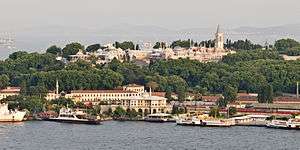
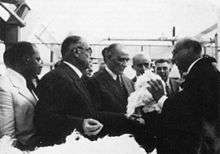


.svg.png)
.svg.png)

